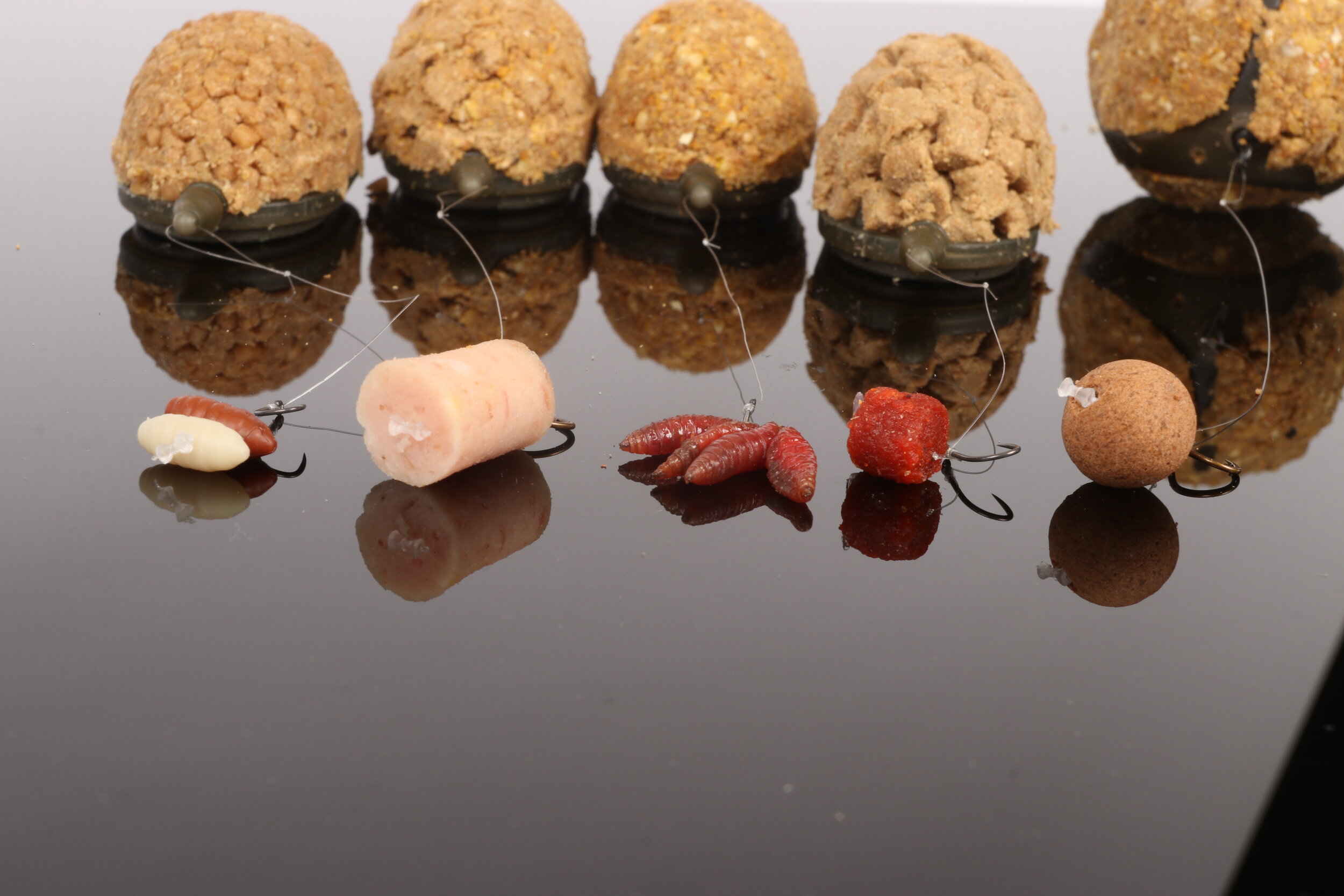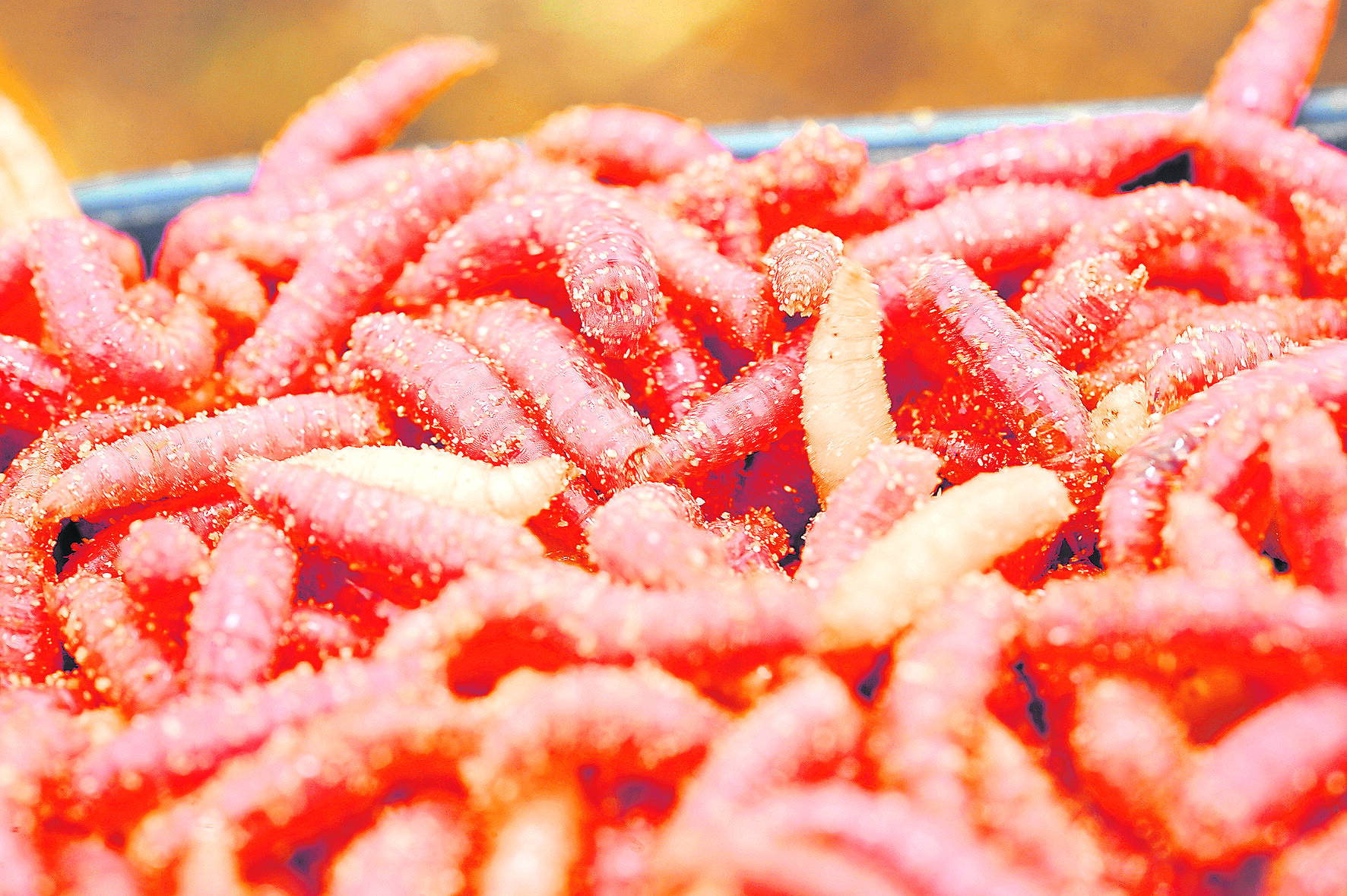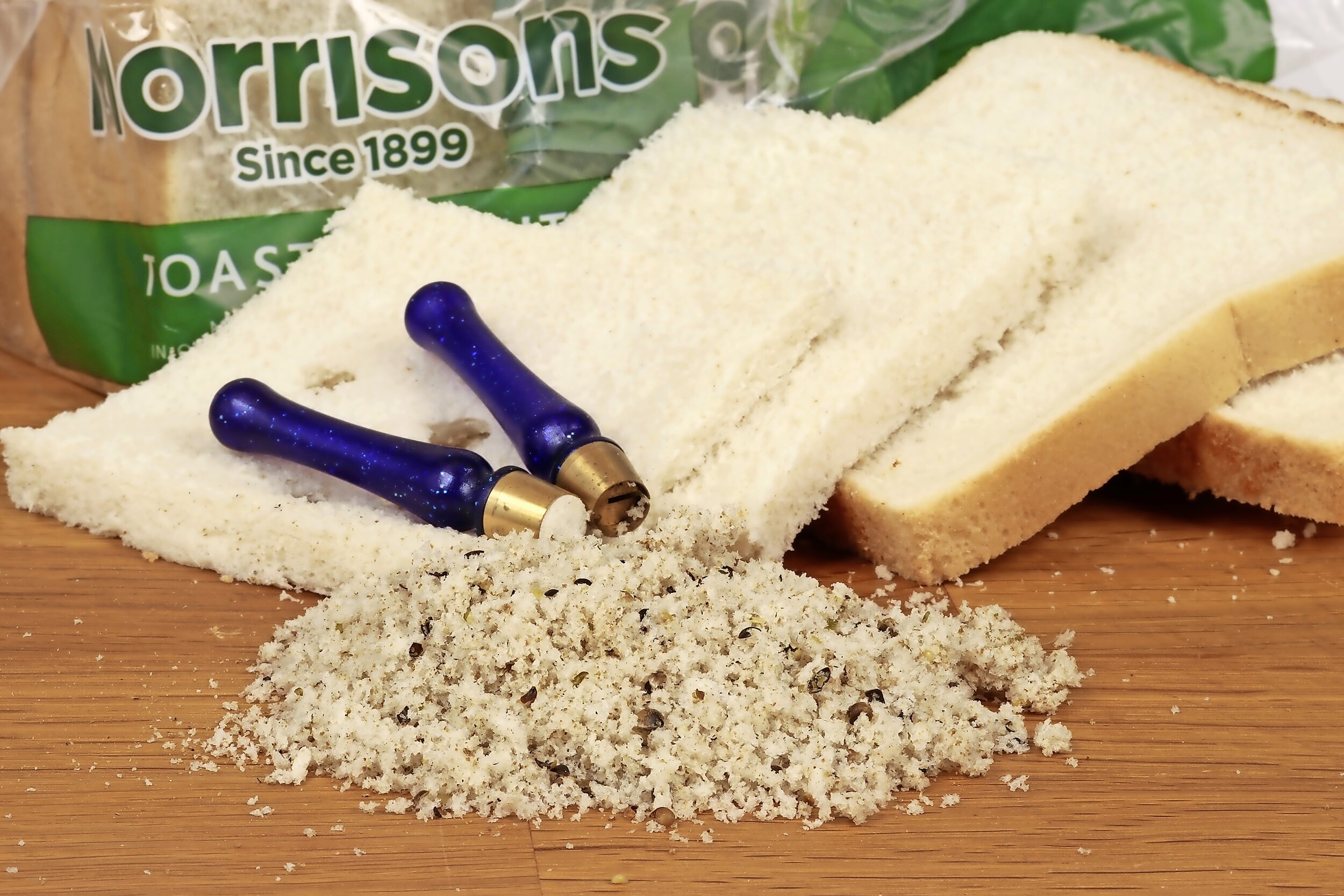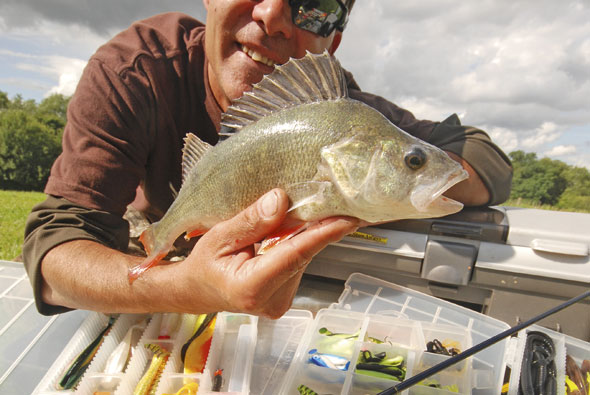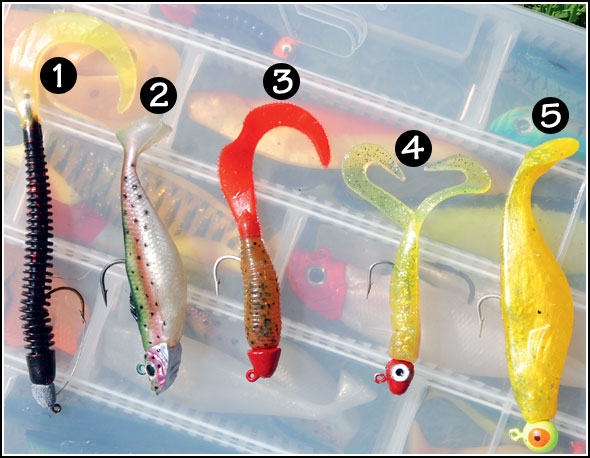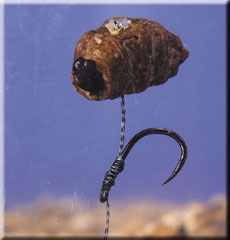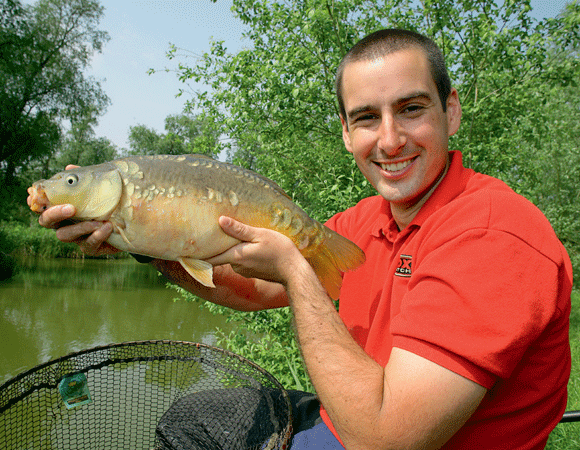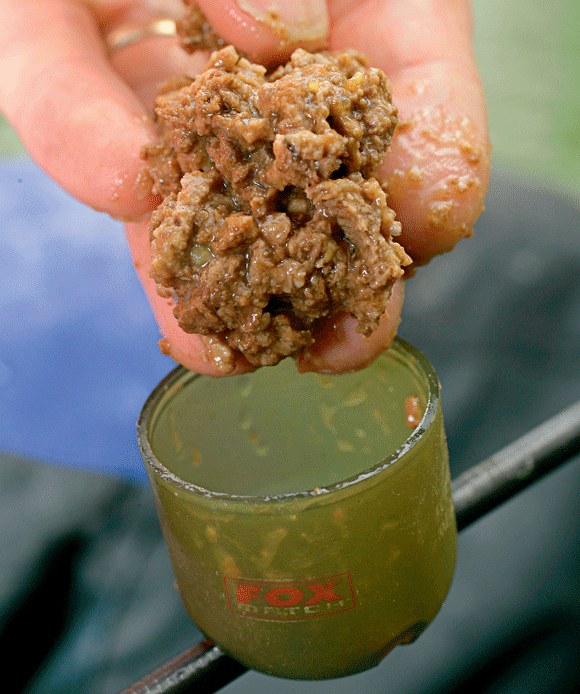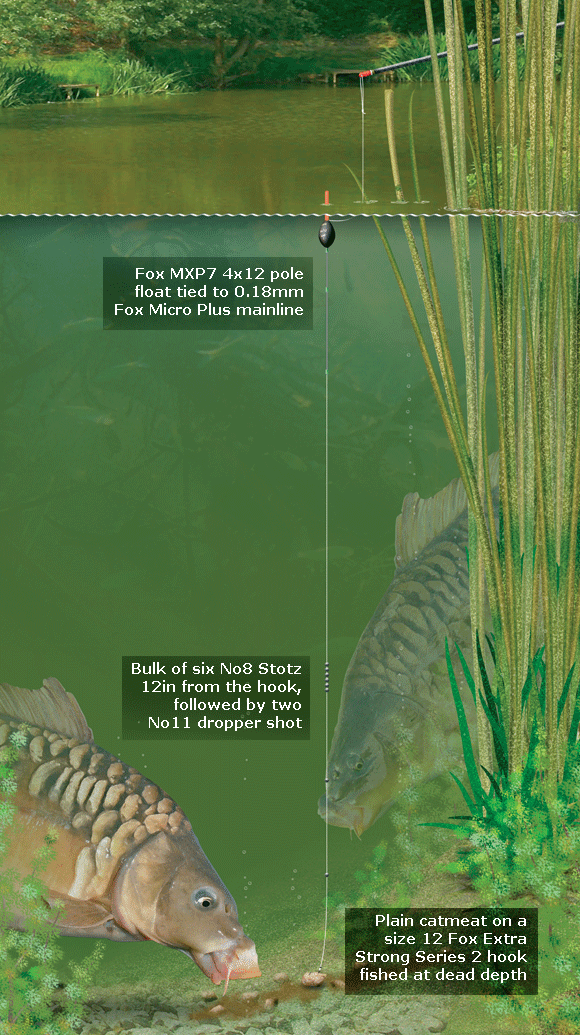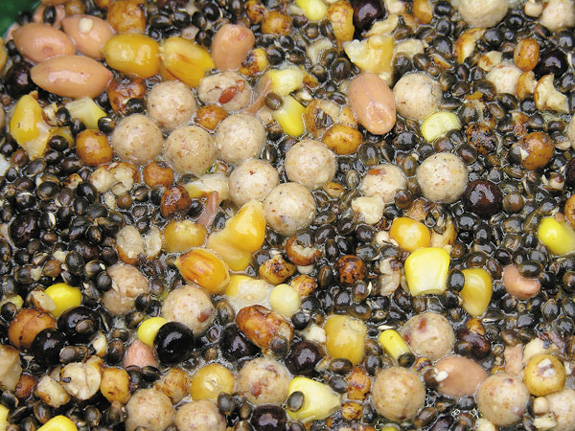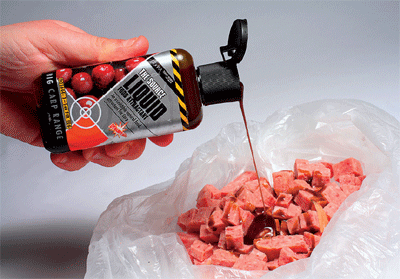How to present buoyant artificial baits pop-up style
Most artificial rubber or plastic sweetcorn grains, maggots, casters, pellets and the like float and that gives anglers a challenge when it comes to presenting them correctly.
Such artificial baits like bread and dog biscuits don’t pose so much of a problem as they are designed to be fished on the surface anyway, so you don’t have to make great alterations to your rig – you can simply fish these baits as you would fish real bread or dog biscuits.
Most other artificial baits need treating differently though, to ensure that you present them as close as possible to how the natural baits look when they come to rest on the bottom.
HOW TO DO IT
Let’s take a grain or two of artificial sweetcorn as an example. First of all you are going to have to fish the rubber or plastic corn kernel upon a hair rig because there’s no way that your hook will ever pull out of the bait if it were side hooked - you’d lose every fish that you hook.
Now, once the bait is on the hair rig it will float unless you alter your rig slightly so that the bait is pulled down to the bottom.
To do this you need to create an anchor for the bait and two of the best forms of anchor are either split shot or tungsten putty. Kryston make arguably the best and it’s called Heavy Metal. This malleable tungsten putty can be rolled between your fingertips to warm it up slightly, then it can be rolled onto the hooklength to create a streamlined weight.
WHERE TO ANCHOR YOUR BAIT
This is quite critical as the position you place your anchor will determine how far the bait sits off the bottom. And then you will have to take into account the make-up of the venue’s bottom. Is it free from weed? Is it silty? Does it have an abundance of Canadian pondweed on the bottom? All these things will make a difference to where you position the anchor for your bait.
On clean and clear bottoms placing your split shot or tungsten putty anchor around 2in away from the hook works well. This will make the bait sit off the bottom by 2in, obviously!
A 2in lift off the bottom isn’t going to look too unnatural, and believe us you’ll get plenty of runs with a bait presented that far off the bottom.
If the venue is silty we would recommend having a 4in to 6in gap between the hook and the anchor weight/s as the weight may sink into the silt but the distance between the weight and the hook will ensure that the bait sits proud of the silt where the fish will be able to find it.
If the venue is very weedy try using a gap of 12in between the hook and your anchor weight so that the imitation bait rises up through the weed and doesn’t become entangled within it.
HOW MUCH WEIGHT TO USE
The amount of split shot or tungsten putty you will need to use down the line will depend upon the buoyancy and size and number of fake baits that you intend to use. As they all vary slightly in buoyancy the only way to find out is to bait your hair rig with whatever fake bait you’re using, add a little weight onto the hooklength and lower the hooklength into the margins to see how the bait performs under the weight of the shot or putty that you’ve used.
The rule of thumb here is to use just enough to pull the bait down – don’t use excessive amounts of shot or a big lump of putty as it’s not necessary. In most situations a BB shot will be enough, or a chunk of putty the size of a 1p.
THE RIGHT HOOKLENGTH
The key to success here is to use a flexible hooklength, so that rules out thick fluorocarbon as that stuff just refuses to bend!
The best hooklength to use is braid as it is soft, supple and will bend really easily at the shot/weight to create a hinge up towards the popped-up bait.
Monofilament is second best as it prefers to lay straight and won’t produce a perfect L-shape at the point where the weight is placed.
As regards the length of the hook link material, that’s up to you. Generally speaking a Method hooklength will be anywhere between 3in and 12in, a specialist semi-fixed bolt rig hooklength will be around 4in to 8in, while a general purpose feeder/leger hooklength will be anywhere between 12in and 3ft. The choice is yours.
POPPING UP OFF THE LEAD
This is a technique that many anglers use when fishing the Method. The buoyant fake bait is fished upon a short hooklength of between 2in and 6in that is tied directly to the bottom swivel of an in-line Method feeder and no weight is used to anchor the bait to the lake bed. Once the rig is cast out the groundbait around the frame feeder breaks down and the fake bait rises upwards to sit between 2in and 6in above it.
Why do fake plastic baits still catch fish?
It seems baffling that any fish in its right mind would ever be caught on a fake plastic bait, but the fact of the matter is they do, and many thousands of huge fish are caught each year on artificial fishing baits.
For hundreds of years pike anglers have been catching their quarry using fake baits, either spinners, spoons or lures, with fantastic results. So why shouldn’t other non-predatory coarse fish suck up a fake bait?
It stands to reason that they should, after all a fish is a fish regardless of its species and where it lives.
The only reason that pike anglers catch fish using artificial baits is because they cast out their baits to the right place at the right time. Some say they catch the pike because they have made the pike angry, but that’s incidental – the bait still has to be in the right place at the right time.
And that’s all there is to catching coarse fish using plastic baits – they have to be cast and presented correctly in the right place at the right time – just like any other bait.
ADVANTAGES OF USING FAKE BAITS
The number one reason why anglers use imitation fishing baits is because they are trying to target specific species such as carp, bream, tench or barbel and they do not want there bait to be chewed and ruined by smaller fish such as rudd, roach, gudgeon or skimmer bream. And one way to prevent that happening is to use a tough, fake bait that cannot be chewed and destroyed.
Other reasons include the ability to easily present a popped-up bait off the bottom where the fish can easily see it, and there’s also the advantage that imitation baits can’t be knocked off the hook or break down like bread, dog biscuits or pellets do.
Finally, you try casting a piece of side-hooked bread crust 50 yards to surface feeding carp. It’s impossible – but not when you use fake bread.
WHY TO FISH TAKE THEM?
There’s no scientific reason why fish take fake baits – the answer is quite simple and not mysterious in any way. They simply fool the fish into thinking that the bait is just the same as natural baits like corn or man-made baits such as pellets.
So long as you are fishing in the right place at the right time and your bait looks natural in the water a fish will come along and take it.
ADDING SCENT TO FAKE BAITS
Most fake baits are simply look-alikes. They don’t smell like the real thing. So in order to attract the fish into your swim out of visual range you’ll have to introduce some scent or face waiting a while for a fish to pass and spot the bait.
This can be done to two ways: you can either flavour the fake bait or you can introduce real items of scented attractants or feed baits.
Flavouring your fake bait isn’t the best option as sooner or later the smell will have fully dispersed. To flavour the baits simply store them in a small canister (a camera film pot is ideal) floating in a liquid additive that suits the bait.
The second method is the most successful though where you feed the real thing around your fake bait – like real grains of corn over the top of your fake corn bait. Or try using a groundbait, a bed or hemp, a bed of pellets or a PVA bag filled with good attractors known to tempt the fish you are targeting.
10 WAY TO USE FAKE BAITS
1) Tip pellets and boilies with fake corn
Tipping bottom baits like boilies and pellets with a piece of buoyant fake corn has several benefits.
First, the brightly-coloured corn helps the hookbait stand out from the crowd, meaning that you get bites faster as the fish home in on the hookbait. Equally importantly, using buoyant corn will counterbalance the weight of the hook and bait, so when a fish sucks up the hookbait it will travel further back in the mouth, securing a better hookhold.
2) Create a tench T-rig
Developed by ingenious tench anglers, the T-rig is a great way of presenting a stack of fake maggots that doesn’t look like a stack! With the baits threaded on to the hair in a T-shape the fake baits stand proud and are more noticeable.
The unusual shape also makes it harder for rig-shy tench to eject the hookbait. Try this presentation over a bed of dead red maggots.
3) Fish a balanced corn stack
Combining floating and sinking fake baits allows you to adjust their buoyancy and make a wafter-style hookbait that is very easy for the fish to pick up. The stack of corn sits upright off the bottom with the hook beneath – very visible but with the metal hidden. Using micro corn at the top gives a more streamlined presentation.
4) Pop-up fake bread
Whether targeting carp or chub, popped-up bread can be very effective, but it takes confidence to cast out such a fragile bait.
Why not replace the real thing with a chunk of fake bread? Use a short hair rig and also hook the bread on, so that it sits really tight to the hook. This way you will definitely hit more chub bites on the river.
5) Hair-rig a fake maggot on the Method feeder
Most of the record-rocking crucians caught over the last few seasons have fallen to fake baits, normally maggots or casters, fished with a small Method feeder loaded with either micro pellets or groundbait. For best results use a size 14 or 16 hook and trim the maggot down so that the hook only just sinks.
6) Make a surface-sighter
Spotting your mixer in a flotilla of other floating baits can be a nightmare, and many’s the time I have struck when the wrong bait has been taken, ruining my chances of catching a big carp!
Now, I always use a ‘sighter’ – a small piece of coloured foam or a pop-up boilie above the mixer – so that I can identify the hookbait amid the feed. A small piece of fake bread is the ideal sighter, proving to be very visible as well as adding to the buoyancy of the hookbait.
7) Tie a medusa rig
This conspicuous real maggot and fake corn combo has taken many big carp, bream and tench. Use it with a PVA bag of maggots attached via a maggot clip below the inline lead and a short braided hooklength. A size 14 hook is tied to the hair and a piece of fake buoyant corn is threaded on and the small hook pulled into it. A size 10 hook is then tied on to leave a small gap between hook and corn. Three maggots complete the rig.
8) Beat small fish with fake maggots
Barbel love maggots, but small chub and dace can make using them on the hook a nightmare, especially at this time of the year on the river. My solution is to replace the real thing with fake maggots on the hair. While small fish will leave the hookbait alone, the barbel are unable to distinguish them from the real thing and will hoover the whole lot up in one go. Fill a large oval blockend feeder with red maggots, and remember to keep recasting regularly to get that trail of maggots going downstream.
9) Dob bread on the surface
Carp are suckers for surface baits at this time of year, but birdlife can make feeding floating baits a real pain in the backside. Instead, I will often rely on the pulling power of a boosted hookbait to attract the carp’s attention. The spongy nature of fake bread is ideal for dipping in liquid additives, and it can then be sprinkled with powdered attractors that will stick to the outside, giving off even more attraction. Dunk the hookbait close to a carp and watch it search out the source of the smell.
10) Make a mag-aligner
This clever rig was originally developed for winter carp fishing, when maggots are the number one bait on many venues.
Since then it has proved super-effective for chub and barbel in the cold and tench in the summer too. With a sewing needle, carefully thread a sinking bronze maggot on to a soft braided hooklength. Now tie on a size 10 hook and pull the fake maggot on to the shank. The fake bait helps to disguise the hook and also acts as a line-aligner, helping the hook to turn in the mouth and prick the fish. With a couple of real maggots on the hook the rig is all set.
Fishing with liquidised sweetcorn
If you are looking for an edge when fishing a commercial carp water during spring, summer, autumn or winter, you will do well by fishing a grain of corn directly over the top of a cloud of liquidised sweetcorn.
Mushed up grains of sweetcorn are absolutely deadly on some commercial waters due to two reasons. Firstly the crushed up kernels produce a yellow, milk-like cloud in the water that disperses flavour throughout the depths pulling fish in from all angles.
Secondly this technique provides masses of attractants but very little food - the only food that the carp will find are small taorn kernels of corn so your whole corn hookbait will stand out like a sore thumb, providing an ideal target for the fish to home in on.
During the winter, when the water temperature is at its lowest, the water is also at its densest. This increase in density means that the cloud spreading out from liquidised corn will linger in the water for longer, attracting fish from far and wide.
Once the fish are attracted to the area, there is little for them to eat except the hookbait. This will mean you get more bites.
Here’s how you make and use it:
1. Tip the tin of corn, juices and all, into a food processor or blender...
2. Do not obliterate the kernels when preparing liquidised corn - give the tinful of corn a five to 10 second blitz then check it and repeat if needed.
3. The finished corn mush should retain a few bits of kernel for the fish to pick over. This helps to hold the fish in the area once the sweet cloud of feed has attracted them.
4. To feed the liquidised corn you must use a pole cup. Dribble a pinch of corn mush into the cup, carefully ship out to the exact spot you’re fishing and drop it into the water. Look at the cloud that spreads out.
TOP TIP
When liquidising sweetcorn, it is possible to add flavours or colours to the mixture to give it a different signature if you wish.
Try fishing with plastic baits to catch big perch
Matt Hayes shows how simple and cheap lure fishing bags specimen perch at this time of year
Bold, aggressive and built to kill, perch are the secret assassins of modern stillwaters.
While most anglers would instantly respond with the word ‘pike’ when asked to name a freshwater predator, the perch has now become top dog in the food chain on many venues.
With many managed waters now devoid of pike, the perch has become the number one predator and in venues boasting a large stock of prolific breeders – typically carp, roach and bream – the source of prey food has risen to banquet levels.
There’s never been a better time to be a perch as the record number of specimens in our lakes testifies.
What’s more, autumn is prime time for perch fishing. Cooler temperatures, less intense sunlight and shorter days means perch can exploit their predatory advantages to the maximum.
As the clarity of water improves and the perch reach a fever pitch of aggressive hunting behaviour, a golden opportunity is created for outstanding lure sport.
Lure fishing – the use of an artificial bait to mimic a fish – is best when predatory fish are active and the clarity of the water is good.
Every autumn I spend a few days fishing for specimen stillwater perch and I often rely on a family of lures known as soft plastics.
These fish-shaped rubbery lures come in thousands of designs, sizes and colours but each is supposed to trick a perch into thinking the target is a small prey fish.
So, as we enter ‘perch time’, I’m going to detail tackle and tactics needed to catch stripies on soft plastics.
The advice I’m giving you will be a good guide to fishing over the next month or two and then again in late March and April when spring feeding conditions mimic those you find now…
Get the right kit
Working a soft plastic lure on an old float or feeder rod really isn’t good enough and if you’re going to lure fish properly you need a few bits of kit that will do a specific job.
Here’s a list of tackle you need, but the good news is you won’t need to remortgage the house. Lure fishing only requires you to buy a few pieces of relatively cheap tackle:
1 - Light lure rod
You need a short, lightweight rod which is comfortable to hold all day, one which is responsive to the lure as it’s worked through the water.
A 6ft-7ft carbon lure rod, with a casting weight rating of 5-15 grams is ideal. I’ve got a couple of old Shimano rods that are no longer available but I suggest you look at the Fox Elite Jig lightweight (£85-ish), the 7ft Berkley Series One Spin (approx £70), the Abu Sapphire Crest Spin rod at about £45 or the Daiwa Regal (£30) and Super Shinobi rods (£70).
2 - Reel and braid
Of all the kit you need a braided mainline is arguably the most important. The almost total lack of stretch in braid, compared to monofilament with a stretch factor of 20%-25%, delivers a host of advantages.
First, thin modern braids cast better, giving your casting greater range than with mono.
Second, due to the lack of stretch and the ultra fine diameter in braid, the lure instantly reacts to any movement of the rod. Thin braid with a breaking strain of 10lb-14lb is needed to cope with the stress of repeated casting and striking. While a 100-yard spool costs around £16 it is more durable than mono and will last two or three years of normal use. What might appear a major cost will become a value for money buy in the long run.
3 - Lures
Most obviously you’ll need to buy some soft plastic lures and a few bits of terminal tackle that go with them. The enormous choice of lures can be bewildering so in this feature I will reveal my top five lures to help you short-circuit the baffling array and pick the best ones.
If you are fishing a water that also contains pike you’ll need some wire lure traces so they can’t bite off your lures.
Making a soft plastic lure come to life
One of the key skills to catching on soft plastic lures is making them behave like fish.
Although many soft lures aren’t coloured like a roach or rudd, their shape and size mimics a small silverfish and you’ve got to get the lure to move as a prey fish would.
This is where the cast and retrieve plays a crucial role.
The most common mistake I see made by newcomers to soft plastic lure fishing is that they are far too violent with the movement of the rod tip.
They rip the lure through the water with fast, whipping movements of the rod tip that not only fail to subtly ‘jig’ the lure but make it do somersaults!
This isn’t the way to catch wily perch. Just put yourself in the position of a specimen predator and you’ll soon see why.
A wildly jumping lure looks suspicious to a big predator as prey fish just don’t swim like that. There’s little chance of a big old perch chasing down a lure leaping all over the place.
When you are using braided mainline, which allows you to feed every inch of rod tip movement through to the lure, you work the bait with flicks of the wrist.
Thanks to the zero-stretch braid, the lure will hop along the deck with a series of soft and subtle lifts of the rod tip backed up by winding of the reel to take up the slack line.
The pictures (above and right) shows how I make a soft plastic lure hop along the bottom using a short ‘jigging’ motion of the rod tip.
I generally use a 12-inch flick of the rod tip to make the lure hop. If the fish are particularly aggressive I will try a slightly bigger movement but in winter, when the fish are less active, a flick of 6-8 inches is all that’s required.
Rigging up a soft plastic – how a jig head works?
One thing that confounds many newcomers to soft plastic lures is the subject of jig heads. Probably because they are alien to any other sort of fishing, many anglers don’t know what they do and how they are used.
Put simply, a jig head is a mini leger with a hook built into it. The hook is speared into the front end of a soft plastic lure which is then carefully threaded down the shank until the head of the ‘fish’ butts against the back of the jig head.
The jig head not only makes sure the lure actually sinks but it also gives it an aerodynamic casting weight located right at the front end of the bait. Not only will this produce good distance on your casts but it also means you can accurately land the lure next to any feature you expect will hold perch.
I use small jig heads weighing 1/32 of an ounce up to half an ounce. They are light enough to produce a lure that hops smoothly with a gentle jigging action yet are heavy enough for you to feel as they rise and fall in the water. This allows you to register the precise moment a perch grabs the bait and interrupts the cycle.
One final point. Rather than tie the jig head direct to the end of the braided mainline, which many people do, I prefer to connect it to a 2ft long leader of 15lb-20lb fluorocarbon line with a clip on one end and a swivel on the other. The swivel is attached to the braided mainline and the clip goes on the ring on the front end of the jig head.
There are two reasons for this. First, fluorocarbon line is stiff so this short length of line acts like an anti-tangle boom that stops the lure wrapping round the braid on the cast and becoming snagged in it.
Second, because perch have brilliant eyesight it is not beyond the realms of possibility that they may be able to see braided line running direct to the lure. As fluorocarbon is invisible underwater it may offer you an important edge if you’re fishing for wary specimens.
How to use a jig head
1. This photo shows a shad-style soft plastic lure and the rounded jig head weight I prefer
2. To mount the plastic on the jig start by spearing the hook point in the front ‘head’ end of the lure
3. Now thread the rubber shad round the bend of the hook and down the shank of the jig
4. The hook point sits mid-way along the lure with the jig head giving great casting weight
Search the water – find your fish
Unlike carp, bream or tench that roll, leap or cruise near the surface, perch are harder to pin down.
As I said at the start of the feature if you don’t have any background knowledge on areas with ‘form’, start your search by heading for swims with structure and/or depth.
Submerged trees and reeds are obvious starting points but in swims with little cover look for areas with extra depth.
I’ve caught perch down to a depth of 30 feet and I suspect they like feeding in deeper water because there is lower light penetration. Perch will be able to use their great eyesight to better effect as they ambush fish that can’t see them.
It is also essential to search each swim methodically with a precise fan-casting technique.
The diagram (right) shows how I approach a swim by making a series of precise casts from left to right. By searching every inch of the water I can be sure the lure has been drawn past any fish in the area.
Perch are suckers for a moving bait which why you often catch them on-the-drop when waggler fishing with a maggot or worm. Working a lure through a series of narrow channels gives perch every chance to see the lure working.
Once you’ve done this – it’ll probably take you 20-40 minutes – you need to up-sticks and move swims.
Because you only need a rod, net and a small bag of lures to go perch fishing with plastics, there is no need to weigh yourself down with lots of kit. Once you’ve exhausted a swim pack up your gear and move on, you could have a change of fortune in another spot.
However, don’t let a failure to catch in one swim make you write it off as a dead area. If you feel confident a swim should produce perch because it has lots of structure or form for producing the goods, be prepared to return to the same spot later as the daylight fades.
On bright days especially, perch that didn’t feed in the middle of the day will go on the hunt at dusk.
Picking the perfect plastic – Matt’s top five perch jigs
I’ll readily admit I’m obsessed with lures. I can’t help it. Try as I might, if I see a lure that’s not in my collection and think it might catch me a fish I have to buy it!
When I’ve been on family holidays to the mecca of lure fishing – the USA – one of my highlights of each trip has been a visit to the Bass Pro chain of tackle shops.
Whether they are fishing for freshwater bass, trout, walleye (zander) or muskies (similar to pike), most American’s use lures so the choice available to them is vast.
Luckily, many of these lures, especially the soft plastic ones, are also brilliant for perch and lots of my favourite patterns are now available from specialist suppliers here.
To ensure you arm yourself with good soft plastics from the start, here are the five I rely on most.
Whatever you do, don’t let your lure fishing for perch start and finish with this handful of designs. Experimenting with different shapes, colours and sizes of lure is one of the most enjoyable parts of the game.
1 – The Black Plastic worm
Perch love lobworms, we all know that, but they also love these black plastic ones. It might be weird that a black worm with a green or orange tail tempts a bite but they love them.
2 – Fox Chubby Shad
Rather than using a sharp jigging technique to make the lure hop, a slow wind combined with a smooth, steady lift of the rod tip will make the Chubby Shad rise and fall. This gives it a different action to other plastics, which can tempt a take.
3 – The Grub
Looking like a stumpy worm or an over-blown maggot, The Grub can be a great change bait if you miss bites on longer plastics such as a worm. Retrieved with a straight wind or a jigging motion to make it hop, I usually get best success on Grubs with a brown body and a bright, contrasting tail colour.
4 – The Twin Tail
Fished with short, sharp jigs of the rod to hop the lure along the bottom. Interestingly, bites usually come on ‘the fall’ as you let the lure sink back to the bottom after jigging it off the deck. Always pay special attention to the sensation of the lure sinking so that you can feel when something interrupts it. This is a classic example of where using zero-stretch braid can genuinely catch you more fish than mono.
5 – The Shad
A two to four-inch long classic shad design, used with a round jig head, is a great perch lure. Astraight wind – where you cast out, let the lure sink to the bottom then slowly wind it back in – is one of the best ways to use them. I also catch well using the classic lift and fall jigging technique. As you lift the lure the tail straightens out; as it falls back down the tail beats. Perch often take the bait as it sinks after the lift.
How to make your own boilies
Ever wondered how to make your own boilies for your carp, barbel, catfish or even tench fishing? Well here's everything you need to know about making your own bait set out in easy-to-follow steps.
Following these steps is not only easy, but believe us when we say that catching your first big fish using boilies that you have made yourself really takes some beating.
Yes - you'll need a few extra items in order to make producing your own boilies easier and faster, but if you intend to create your own baits regularly, you will quickly make up the cash that you have laid out on the rolling table and other equipment.
Not only will you quickly save cash, but you'll have the flexibility to create rock hard baits for those long sessions, or very soft baits for when bites are really easy to come by. You could create your own bait flavours, you could place cork balls within the rolled boilie mix to create pop-ups, and you could save some of the mix for paste - great for wrapping around your boilies to give them even more attraction.
Making boilies however doesn't have to be a chore. It also opens up a whole new world of possibilities and all you have to do is follow our simple sequence below which will guide you through this very easy recipe.
Mix all the powdered ingredients together really thoroughly in a large bait bucket.
Crack four large eggs into a mixing bowl and add the liquid additives and food colouring.
Slowly add dry powder to the eggs, never the reverse. Do this until a sticky paste is produced.
Put the paste in a resealable bag and leave for five minutes until all the liquid is drawn into the bait.
Pinch off a small nugget of bait and roll it between your palms until a round ball is produced.
To produce wafter hookbaits I add a handful of cork dust to the dry ingredients before mixing.
For pop-ups that stay buoyant indefinitely mould a small amount of paste around a cork ball.
Boil the baits for around one minute to give them a tough outer skin.
Lay the boilies out on a sheet of plain kitchen towel and allow them to dry for an hour or so before they go into the freezer.
7 top boilie making tips
Here are seven more great tips to help give your home-made boilies even more pulling power
When preparing winter baits, use ethyl alcohol-based flavours. This is a highly water-soluble solution, ideal for adding an instant flavour hit around the bait.
10ml to 20ml of fish oil added to your bait not only adds extra attraction, but also makes the baits easier to roll.
Make your baits bright with the addition of a powdered colour. Carp will first be drawn to a food source by its appearance, just like humans.
Make critically-balanced baits by using approximately 60percent bottom base mix and 40percent pop-up mix.
Add a palatant to your bait mixture. These bring out the best in your chosen base mix and flavour combination.
Use different shaped baits like squares, tubes or triangles, rather than standard round balls.
Don’t just use tackle shop flavours. Experiment with things like curry or chilli powder, oyster sauce or even shrimp paste.
How to get more bites with artificial baits
Artificial fake fishing baits have been around for years, and despite being produced from plastic they are some of the finest baits available to anglers.
There are many different types of fake bait on the market, with each being perfect replicas of the real thing.
Specialist and pleasure anglers across the country have had fantastic results using them, with many huge fish being caught on single artificials, or artificials presented over the top of a bed of real bait.
Not only do they look like the real thing, most are buoyant, and this allows the angler to fish the baits just off the bottom, in full view of any passing or nearby fish.
They work for carp, chub, barbel, tench and bream, they work throughout the year, and they will work on canals, rivers, streams, vast lakes and commercials. And they can be used over and over again.
Here's an in-depth guide to show you what's on the market, and help you decide which fake bait would be best for the fish you target...
Corn
Imitation corn has accounted for loads of specimens this season, either used by itself or in conjunction with real corn grains. It is buoyant so by carefully selecting the right weight of hook and by adding one or two real grains of corn you can critically balance the bait so it rests gently on weed, or wafts off the bottom when a fish passes. It is available in red, orange, yellow and even black, and some companies produce it in different sizes to imitate small kernels through to larger pieces of maize.
Tigernut
Previously the only way to pop-up a tiger nut was to use a buoyant section of foam hair-rigged above the nut. This was hardly ideal. Now though you can use a spittingimage nut that already has enough buoyancy to hold up a real nut, plus a strong, heavy hook too. These make great alternative carp baits that are actually soft enough to be side hooked, if you wish, but tough enough to be hair-rigged for long range casts.
Bread
Many carp anglers breathed a sigh of relief when imitation bread was launched earlier this year. It’s solved the dreaded problem of bread flying off the hook upon the cast or being nibbled off the hook by nuisance rudd when surface fishing for more substantial carp. It is incredibly resilient and can be side hooked and cast as far as your muscles allow. And not only is it great for surface work, imitation bread can be popped-up off the bottom, over a bed of white bread crumbs.
DoppelGanger
This malleable imitation bait from Kryston is available in sweetcorn and halibut pellet flavour. It’s a small block that can be moulded into whatever shape you wish. The best way to present this soft paste-like bait is to tie a bead upon a hair-rig and mould it around the bead. It is incredibly buoyant and obviously the more you use, the heavier the weight needs to be to counterbalance the bait and pin it just off the bottom.
Pellets
Halibut and trout pellets sink like a stone, so when a carp finds a critically balanced or popup pellet over a bed of real ones it should certainly attract their attention. Barbel and chub are fond of pellets too, so a buoyant pellet wafting just off the bottom may prove too must to resist. A variety of different sizes are available to suit the species being tempted, plus the pellets can be sliced into smaller sections very easily if you want to critically balance your bait so that it comes to rest naturally over silt or weed.
Maggots and casters
Side-hook two or three false maggots or casters and you will counterbalance your hook, making the bait flutter enticingly off the bottom, right where the fish can find them. This technique has been widely used on stillwaters and rivers by many of the countries top specialist anglers - to great effect. These small, buoyant baits are available in a wide range of colours to suit the different shades of casters and the colours of maggots.
Dog biscuit
The best thing about using imitation dog biscuits is that they don’t take on water and sink like the real thing does! They look almost identical and are soft enough to be side hooked or hairrigged. There is one small problem with them though and that is your hook will always hang underneath the bait in full view of the fish. Enterprise Tackle has solved this by creating false biscuits that feature a removable counterweight that ensures the bait sits the same way up every time, and therefore your hook points to the clouds, out of the carp’s view.
Fishing with bread - the magic mushroom tactic
The carp’s love of bread has been well documented and the gurgle of a gluttonous carp slurping down a hunk of floating crust is one of the sounds of summer.
But there’s always been a flaw with bread crust, flake or punch – most other species love the white stuff, too.
Small rudd, roach and bream love pecking at mushy bread and in lots of fisheries hoardes of silverfish can whittle away a hookbait in minutes, leaving the angler with an unbaited hook.
The soft texture of bread also means it’s prone to flying off the hook when a float, feeder or leger is cast out. Even if the bread stays on the hook during the cast it’s easily torn off the rig when it hits the water.
Indeed, it’s the fear of sitting behind an unbaited rig that has convinced many anglers to dismiss bread as a hookbait.
Well here we meet a man who has created such a brilliant bread method that he’s even banned it at his own fishery!
Meet the bread man
John Bennett is the 60-year-old owner of the well-known Rolfs Lake fishery near Wheatley in Oxfordshire and the man who has taken the art of bread fishing into new territory.
A regular fisherman at the 40-peg venue prior to taking control of the pool in December 2007, John knew that bread remains a great bait for carp and he also recognised the fish in his own lake loved it.
Although floating baits are banned at Rolfs those who did persevere with sinking bread punch or flake bagged tremendous catches.
Furthermore, if John tossed a bit of bread on to the water when the lake was closed or free of anglers, the fish went crazy for it and instantly slurped in down.
But, as every angler who’s fished with bread for any length of time realises, the fact that it gets blitzed by small fish and doesn’t stay on the hook very well made it difficult to efficiently fish with.
“Like many modern lakes Rolfs is not a ‘carp only’ fishery. There are masses of silverfish and they often pounce on normal bread hookbaits as soon as they hit the water,” John explained.
“You get loads of tiny taps on the quivertip as roach whittle away the bait, or your float dips and bobs as they nick the bait.
“It’s a nightmare, even though the carp love bread I often couldn’t keep a bait in the water long enough for the big fish to find it!”
Putting his grey matter to work the Swindon angler began developing a new presentation for bread that would make it impervious to small fish yet maintain its attraction to carp.
His idea was to somehow compress the bait to make it firm enough to resist small fish and being ‘cast off’ the rig. After much experimentation the ‘Mushroom’ was born.
Made with a Seymo Lunch Punch bait punching tool he created a hookbait with a tough ‘stalk’ of compressed flake topped with a ‘cap’ of softer bread (see sequence).
1. The key equipment is a 12mm Seymo Lunch Punch (£4). Load it with 6-10 punches of bread
2. Press the Punch against your hand and gently compress the plunger to compact the bread
3. Relax the pressure of the Punch and push out a cap of bread against your palm
4. Release pressure totally and push the plunger right down to reveal the bread mushroom
5. With a Preston Quickstop on the end of your hair rig push into the bread to sit on the stop
6. Here’s the finished article – the hard ‘stalk’ is topped with a softer ‘cap’
This Mushroom is tough enough to withstand the attentions of small fish and the force of casting but it still retained a soft enough cap to be tempting to fish that love the soggy texture of waterlogged bread.
“The Mushroom solves all the problems of bread fishing,” said John. “The punched stalk is amazingly tough, it means you can cast the bait as far as you want and small fish can’t whip it off the rig.
“However, the cap is a little thinner and less compacted than the stalk so it softens a little and swells up as water soaks into it.
“This gives little fish something to nibble at which I think actually advertises the bait to larger carp swimming nearby. I often get little taps on the quivertip as silverfish nibble at the bread until a carp comes in and sucks up the whole bait.
“You certainly know about it when a carp’s grabbed the bait – nine times out of 10 the rod whips round and you’ve got to grab it before it goes swimming!”
Showing how to punch out the mushroom-shaped nugget of bread, John threaded it on to a hair-rigged leger and blasted the rig right across the pool to the far bank margins where the branches of a stumpy tree trailed in the water.
The tough stalk of the bait prevented the monofilament hair rig cheese-wiring the bread on the cast while the ‘drag’ of the bait as it flew through the air ensured the leger and hookbait remained separated and didn’t tangle.
When the rig hit the water two distinct splashes could clearly be seen as the leger, then the hookbait, landed.
The Mushroom had ticked another box in the ‘advantages’ table – its shape, size and weight means it’s a great anti-tangle set-up.
Settling down to watch, his gently curved quivertip John explained how he expected line bites and taps on the quiver to register first.
Even though a deluge of rain had pushed up the water level of the stream-fed lake by four inches in the previous 36 hours, he was still hopeful the longer daylight hours would stir the carp from their winter slumbers.
Sure enough, five minutes after casting a couple of slow two-inch pulls on the tip indicated fish had brushed against the line.
A few minutes later a series of taps indicated small fish had found the bait and were trying to nibble away tiny sections from the swollen cap of bread.
Then it happened. Without any warning the top half of the rod wanged round and John grabbed the reel seat before it headed lakewards.
There was no need to strike, the fish had taken the bread so positively it had hooked itself, John picked up the bent rod and tightened the line into the fish.
After a five minute battle that saw the lethargic carp plod up and down the margins of the lake as if it was waking up and didn’t quite know what was going on, he guided a gorgeous heavily-scaled mirror carp into his net.
Weighing 11lb-12lb the fish was in prime condition and as he reached into the net to unhook it John pointed out the bread Mushroom which was still on the hair rig.
“The stalk of compacted bread is so tough that the bait is usually still on the hair when you land a fish,” he said.
“When they’re really having it I’ve often caught two or even three fish on the same hookbait. I unhook the carp and chuck out the same Mushroom again!
“I can’t think of any other bread hookbait that stays on the rig so well that you can recast it.
“Which bread you use isn’t vital but ‘budget’ loaves are usually best as they have a doughy, sticky consistency. When you use the Lunch Punch on them they compress better to form a harder ‘stalk’.
“To be honest, the Mushroom is so effective and it was dominating the fishing so much on here that I decided to ban it. There’s lots of carp in here and nobody was using any loosefeed because they were just using a few slices of bread. The fish weren’t getting enough food!
“It is a brilliant method though and in lots of lakes it’ll be a great way to avoid the silverfish and pick out the carp.”
Easy to learn
How to use catmeat
Catmeat is one of the most effective summer commercial carp baits. Everything that we anglers dislike about catfood – the smell, the mess, greasy and oily texture – is absolutely adored by fish. Especially carp.
Add this to the fact that catmeat comes prepackaged in fantastic carp-attracting flavours like pilchard, tuna, salmon and sardine, and it’s easy to see why it is such devastating bait.
Another advantage of catmeat is its soft texture, something else that carp go for. And another plus point to this underused bait is that it’s super cheap, generally costing between 30p and 40p per tin.
To witness the power of catmeat, we joined Steve Cole, on the banks of Decoy Lakes, near Whittlesey, Cambridgeshire for a lesson in how to most effectively use it.
Steve takes a unique approach to his catmeat fishing by using it in three different ways on the same day. This allows him to target several areas with slightly different tactics from the comfort of one peg and pretty much guarantees that he’ll take rakes of fish from all areas within one five-hour session.
We set up on Decoy’s popular Willow Lake for a masterclass in catmeat fishing that you’ll find really easy to follow and copy.
Here's how Steve fishes this deadly commercial carp bait using pole tactics...
Why use catmeat?
Love it or loath it, no angler can argue about the magical fish-pulling spell catmeat seems to cast over carp. The fact that it is such an oily, slimy, rancid bait for us to handle, is its main attraction for the fish. Being meat, it is packed with protein, ideal for when carp are heavily on the feed.
Add to this all manner of different flavours – some anglers preferring the meaty varieties like heart and beef, while others place their faith in the fishy varieties – it is second to none when it comes to targeting highly-stocked commercial venue carp.
But with so many different meats on the market, it can be confusing to know which one(s) to choose.
“The cheap stuff is what I always go for,” Steve told us.
“Also, always use catmeat chunks in gravy, rather than the solid meat products.
“The great thing from an angling perspective is that the really cheap stuff is probably best. The one I use comes from the supermarket Lidl, either Coshida or Opticat which cost about 30 pence a tin.”
Unfortunately, there are a couple of drawbacks with using catmeat.
The first one is that it is a seasonal bait. Being a high protein food, it can only really be used when the carp are hard on the feed, usually between mid-May through to mid- September.
Steve revealed that he had used it in the colder months but you have to fish it on the right days and be very sparing with the amount of free offerings you put in. The second drawback is that it is banned on some commercial fisheries.
“In my opinion, catmeat has received some bad press over the years, leading to it to be banned on some fisheries where owners have deemed that it damages the fish,” Steve added.
“The trouble has been a minority of anglers piling in two dozen tins or more at a time and this has ruined it for the more sensible anglers among us. Two or three tins are more than enough for a session.
“Furthermore, I think if it is good enough to feed pampered cats, then it should be fine for carp, too.
“Also, I’m fishing today at Decoy Lakes – one of the countries premier match and pleasure complexes. The owners of this venue don’t ban catmeat and their fish stocks are healthy and the catch rates remain prolific – some of the highest in the country, in fact.”
How to prepare the catmeat slop
To prepare catmeat slop, simply push the lot through a fine mesh riddle. It can then be fed into the swim using a small Fox Toss Pot or pole cup attached to the end of the pole’s top-three section. The beauty of this is that you can be 100 per cent accurate.
The slop, once in the water, creates a lovely oily, greasy cloud of smell and attraction, but with nothing solid for the carp to feed on – apart from your hookbait.
The thing to avoid when using slop is not to use it in water that is deeper than three foot as the cloud will disperse too wide and the tactic will lose its effectiveness.
“When it comes to using the slop, always have a tub of water next to you because if you don’t wash your fingers after handling it, catmeat gets everywhere” Steve warned.
“Also, there are a number of different liquid additives on the market like Liquid Catmeat. These may make a difference, but I don’t see the point in using them – it’s gilding the lily.”
STEP ONE
Empty a whole tin of catmeat on to a fine mesh riddle.
STEP TWO
Push all the contents through the mesh of the riddle.
STEP THREE
Lots of it will stick to the bottom of the riddle, so just wipe it in to your bait tub.
STEP FOUR
The finished product is a fine, oily and meaty goo that fish adore.
Preparing the hookbait
Although there is simply nothing wrong with using the chunks of catmeat straight from the can, there's always something an angler can do to 'pep-up' the bait to make it even more appealing to carp. And also to make the bait stand out from the feed. And also to put you ahead of the angler on the next peg.
Steve utilises Dynamite Baits Green Swim Stim groundbait to give his catmeat chunks a coating that provides even more attraction.
Here's how it's done...
STEP ONE
After washing off the catmeat, by tipping it onto a riddle and rinsing, you'll be left with clean chunks of meat. Now take a bag of Dynamite Baits Green Swim Stim and sprinkle the crumb over the top.
STEP TWO
Very carefully push the chunks of meat around in the groundbait to ensure that each piece gets a good coating of the green fishmeal groundbait.
STEP THREE
The groundbait sticks to the meaty chunks to not only provide an extra scent trail, but it also forms a tougher outer layer which helps it stay on the hook at range.
SWIM ONE
Island margins
The first of Steve’s three-swim approach involved fishing up to the margins of Willow’s island.
Carp regularly patrol these features as at this time of year to be in the warmer, shallow water.
The trouble is that they go round and round, so it is up to the angler to stop them, forcing them to feed.
With most commercial islands being nine to 16 metres away, many people just fish sweetcorn or pellets because catmeat is so soft it is hard work to fish at distance. But to force patrolling carp to feed, Steve uses catmeat slop.
“Carp usually see pellet after pellet, but they’ll leap on catmeat, because it’s different. This is why it’s effective against far-off features.”
Kick off and feed
Once the slop is prepared, Steve fishes it through a Toss Pot because he’s aiming to build the swim slowly, rather than piling in a load of bait at the start.
By priming the swim with a large pole cup, you bring too many fish into the swim which will result in a lot of foul hooking, ruining the swim before you’ve even started.
With a smaller Toss Pot, Steve can feed, put his bait over the top – in this case the hookbait is a 6mm punch of plain luncheon meat – catch a fish and then repeat the process. This has the effect of slowly building the swim. The more bites he gets, the more bait goes in, the more the swim builds. If he doesn’t get a bite within four or five minutes, only then will he pot in another Toss Pot full of slop.
“You still need bait going through the water, just not too much at once, because the swim will be full of fish and it will be total chaos with fish racing all over the swim,” Steve said.
“By adding slop little and often, you keep greater control over what is happening beneath the surface.
“You can only catch one fish at a time, so why have the swim crawling with loads of carp? All you get is lots of foul hooking which then spooks the fish.”
The hookbait Steve uses on his long island line is either punches of luncheon meat or, occasionally, sweetcorn. These baits are more robust than cubes of softer catmeat so they’re easier to fish at distance, staying on the hook better.
SWIM TWO
Open water
When targeting his open water swim, Steve starts by finding the average depth of the water – generally three to eight foot on most commercial pools.
As well as fishing to the island, Steve plumbs up an area 45 degrees to the left of his island swim. This keeps his second swim away from the first.
Also, if he fishes in line with the island in his open water swim, every fish that is hooked near the island will be played through this second swim. This will spook any fish feeding in this area.
By keeping the second swim on a different line, he can get the carp feeding confidently in both areas.
When fishing in open water, Steve will feed catmeat straight out of the tin then fish ‘dusted’ catmeat over the top. Dusted meat involves washing off any gravy and sludge from the tinned meat then covering it with a sprinkling of dry groundbait.
Steve uses Dynamite Baits Green Swim Stim but any groundbait will work as long as it has a fine consistency so that it will stick to the meat.
“The groundbait creates an outer shell, toughening the meat,” Steve said.
“This process allows me to fish this soft bait at longer lengths, like today where I’m fishing at nine metres.”
The other beauty of creating a groundbait jacket is that there is a little more attraction coming off the catmeat as the groundbait breaks down.
To kick off this open area, Steve feeds a full pole cup of plain catmeat then leaves the swim to rest for an hour. After this hour he’ll fish for five minutes. If there are no carp forthcoming, he feeds the same again then leaves the swim for 30 minutes before trying again.
“The reason for leaving it an hour is so the fish in open water gain confidence,” he said.
“I’m looking for a fish straight away. If there are no bites, feed and look again in half-an-hour, just in case the fish are coming in, eating and leaving.”
SWIM THREE
The margins
Steve’s final swim of the day is in the margins. He targets this area only in the last hour of the session and doesn’t feed it at all until he is ready to fish there.
“The reason I wait till the last hour to feed and fish is that I’m trying to replicate an angler leaving for the day and throwing all their left over bait in,” Steve explained.
“The big wary fish know that later in the day these areas are safe and that they can get free food.”
To imitate a departing angler, Steve cups in three full pots of plain meat – gravy and all. He also cups it in from a height to resemble food that’s being thrown in. He will then spend the entire last hour fishing on this line when he could catch up to 50lb or more!
“I always use straight meat rather than slop in the margins as it is better for attracting larger fish,” Steve said.
“Over the top I fish a single chunk of plain meat to resemble the rest of the freebies.”
If bites dry up for 10 minutes, he’ll cup another full pot straight in.
The session
Starting the day against the island with his foul-smelling catmeat slop, Steve very quickly had his swim fizzing and bubbling as the fish drove themselves into a feeding frenzy.
A 6mm punch of luncheon meat on his hook kept bites from carp and F1s coming very steadily through the next hour.
Then it was time for Steve to look in open water. With no bites after five minutes, it was in with another pot of meat and back to the island.
After four hours, Steve was taking fish with frightening regularity from the island swim.
He’d also had a couple of large carp from open water to boost his already impressive catch. With only an hour left, it was into the margins.
Following his own advice, Steve scattered four large pots of catmeat next to a clump of reeds, before following this up with his margin rig.
Within seconds the fl oat buried and he was into a good carp, which tipped the scales to around 6lb.
By the end of his five-hour session each of Steve’s three swims had produced more than 40lb of fighting-fit carp and F1s.
He managed to keep three swims going with essentially the same bait. But by applying a little thought Steve had shown three very different uses for catmeat.
Although he used three different presentations on the day, Steve’s approach is by no means exclusive to catmeat. By thinking outside the box you too could add spice to a bait you probably thought could only be fished one way
Steve shows off his superb haul of catmeat-caught Decoy Lakes' carp
How to make your luncheon meat more attractive
Carp absolutely love luncheon meat, so fishing with cubes or torn strips of meat can prove deadly on most commercial carp waters. Tench, bream and barbel love it too.
But, most anglers know how effective luncheon meat can be, and after many months of meat being used on a venue the fish can switch off to it.
Many anglers refer to this as 'being blown' - where the bait has been so overused that the fish steer well clear of it.
That's the time when you need to try something a little different, namely flavouring the bait so that the fish view it differently and therefore will suck it up again.
Here's just one way that you can alter the flavour (and texture) of your luncheon meat, and persuade the fish into taking it again...
1. First, pour the contents of two tins of cubed up meat into a large groundbait bowl
2. Pour icing sugar on to your palm, although very sugary drinks will work just as well
3. Sprinkle the icing sugar over the cubes of luncheon meat
4. Lightly work the icing sugar into the meat, being careful not to break up the cubes
5. After a couple of minutes of mixing the oils will start to ooze out of the meat
6. Once all the meat has turned sticky and oily, pour dry groundbait over it
7. Again, the dry crumb should then be carefully worked on to the meat until all of it is covered
8. Riddle off the excess crumb. The meat can then be bagged up or used immediately
How to boost meat bait by powdering it
Sometimes the usual shop-bought luncheon meat won't produce fish like it used to, and that's probably because anglers have been using it on the same venue week in week out and have caught loads of fish on it.
The fish aren't daft - they will soon wise up to the fact that if they suck up a particular bait they will have a quick trip to a keepnet, so they begin to avoid them.
But there are certain things you can do to baits to make them appeal to the fish again, and in a way, trick them into takign the same old bait again.
One way to switch the fish back on to lunchean meat is to give it a powdered dusting that alters the bait's flavour slightly, and here's how it's done...
1. Pour off liquid and keep, as this can also be fed into the swim
2. Empty the drained meat chunks into a plastic bag
3. Liberally cover the damp meat with dry The Source groundbait
4. Lightly scrunch the bag to fully cover the meat in powder
5. Leave the coated meat 30 minutes or overnight to adhere
6. To mount, take a baiting needle and push it through the meat
7. Hook the needle on to the hook and carefully pull it through
8. Pull the hook all the way through the meat chunk
9. To finish, turn the hook 90 degrees and press into the cube
How to prepare particles
If primed correctly on the right occasion, particle baits can prove to be more effective than boilies. They are great as a feed, hook and holding bait. The choices available now are huge, so there will be something to suit every situation.
‘Particle’ refers to a wide range of beans, nuts, peas and seeds. If prepared right, the natural oils, sugars and flavours are given the chance to blend with the fish’s natural feeding environment.
It's crucial that anglers prepare particles correctly as a fish that eats uprepared particles may suffer due to the seed or nut expanding within the fish's digestive system.
We recommend that every angler who intends using particles - either as an attractant, as loosefeed or as hookbait - fishes responsibly and follows the guidelines below...
Particle
|
Pre-soak |
Boil/Simmer | ||||
 |
Hemp |
12-14 hours |
Until split | |||
 |
Tares |
12-14 hrs |
20-30 mins | |||
 |
Standard tiger nuts |
24 hrs |
30 mins | |||
 |
Premium tiger nuts |
24 hrs |
30 mins | |||
 |
Chopped tiger nuts |
12-14 hrs |
10-20 mins | |||
 |
Peanut kernels |
12-18 hrs |
20-30 mins | |||
 |
Wheat |
6 hrs |
10-15 mins | |||
 |
Whole maize |
24 hrs |
30 mins | |||
 |
Flaked maize |
Not needed |
1 min | |||
 |
Maple Peas |
12-14 hrs |
20-30 mins | |||
 |
Groats |
Not needed |
1 min | |||
 |
Chick Peas |
12-14 hrs |
20-30 mins | |||
 |
French Mix |
Not needed |
1 min | |||
 |
Blackeyed Beans |
12-14 hrs |
20-30 mins | |||
 |
Red Kidney Beans |
12-14 hrs |
20-30 mins | |||
 |
Carp Krunch |
6 hrs |
10-15 mins | |||
 |
Moth Beans |
Not needed |
1 min | |||
 |
Red/White Dari |
6 hrs |
10-15 mins |
Hair-rigging pellets using the lasso method
There are many ways to hair-rig hard pellets, but some of these methods require a drill or a bottle of Superglue. But what happens if you don't have either of those things? What do you do then?
It's actually possible to tie a large halibut pellet onto a hook hair, using a neat lasso formed from your hooklink material - and that can be either mono or braid - either will do the job effectively.
If the hooklength you are using happens to be a coated braid, you'll need to strip back quite a lot to enable you to tie your pellet on effectively.
So, here's how to tie it in eight simple steps...
1. Make a loop in your hooklength, you’re going to tie a grinner knot
2. Thread the end through the loop.
3. Make sure you pass it through at least four times.
4. Tighten down the loop - but not too far!
5. Slip the pellet into the noose you’ve created.
6. Trim off the tag end with a sharp pair of scissors.
7. Using the knotless knot, attach the hook.
8. Using another grinner knot, attach the swivel. The rig is now finished.
How to use a Method feeder groundbait and pellet mould
The Method feeder is a deadly stillwater tactic for carp, bream and tench, but loading the feeder the traditional way can be a lengthy process, that's where a Method feeder mould really comes in handy.
This clever device creates a perfect Method ball almost instantly, saving you vital minutes which can be spent catching more fish.
Here we explain how it works and suggest several ways to get the most from your simple yet effective Method feeder mould.
One point that ought to be mentioned immediately is the fact that Method feeder moulds can be used to compress either groundbait or pellets around a frame feeder. Some prefer to use simple groundbait, while the more inventive and creative anglers among you might like to use pellets. Afetr all pellets presented on a feeder has been THE best tactic to use recently.
And what species might you typically catch when using a Method feeder? Well it'll be carp, bream and tench most likely - bottom feeders mainly. But of those three species, carp are the likely candidates to be attracted to the scent of the groundbait or pellets, respond and swim over to take your bait.
Here's how it's done...
1
Empty a bag of 2mm pellets into a suitably sized bait box and cover
them with water (lake water is fine, but tapwater will do).
2
Leave the pellets to stand for around an hour to soak up the water. They should be reasonably soft after this and you should be able to squeeze a handful into a ball that holds together. Pellets of this texture are perfect for moulding around the Method feeder.
3
Band a 6mm or 8mm hard pellet and place the baited hook centrally into the bottom of your empty Method mould.
4
Fill the Method mould to the brim with the soaked 2mm pellets. Your hair-rigged hookbait should be buried beneath the pile of bait.
5
Take the Method feeder and gently press it into the mould. This will help the 2mm pellets and your hookbait take on the exact form of the mould every time.
6
The feeder should look like this once out of the mould. Note the hookbait on top of the pile of bait, highly visible to fish and leading to more bites and bigger bags!
7
Groundbait can also be used with your Method feeder and mould. Specialist groundbaits for Method feederfishing are available, and these should be mixed reasonably wet but not sloppy. It is then a simple matter of following steps 3 to 5 above to help create a neat ball, again with the hookbait fully visible.
TOP 10 METHOD FEEDER TIPS
1
A flat Method feeder is best when feeder fishing close to islands. These usually have a small shelf or slope that the fish patrol. An oval Method ball could easily roll down the slope or off the shelf away from the fish, but a flat Method feeder will stay in the targeted area where they are on the hunt for food.
2
Experiment with the colour of your groundbait or pellets. Try a bright mix or dyed pellets. Dynamite Baits Spicy Tuna and Sweet Chilli benefit from flavour and colour additives that fish will find irresistible!
3
Always use a very short hooklink of between three and four inches. This will allow the fish to slurp the bait up without feeling any instant resistance. Once it does feel the weight of the rig it is too late because the hook will already have taken hold in its mouth.
4
Don’t be afraid to feed via a catapult over your target area. This will add extra bait to the swim and also create a splash which the fish will be attracted to. Feeding large pouchfuls infrequently will help keep the fish on the bottom.
5
Recast your feeder at least every five minutes. If you are not getting bites, this is a great way of building a big bed of bait up in your swim. Once the fish turn up, they will have plenty of loose offerings to feast upon and this should keep them in your swim for a long time.
6
Use the line clip on your reel to achieve consistent distance. At the start of the session, cast to your target area. If you land a few metres short, peel the necessary amount of line off the spool and clip-up. Keep recasting, peeling more line off and clipping-up until you are tight to the fish-holding feature.
7
Your hooklength will be put under a lot of pressure when using the Method and must be strong enough to deal with these rigours. When fishing for carp up to 5lb use 0.18mm or 0.22m for fish that run into double figures.
8
Your hook size will depend on what bait you are using. Use a size 14 for an 8mm pellet or small white boilie, and a size 16 for maggot or corn.
9
Use a hookbait that stands out significantly from your groundbait or pellets. Carp are likely to snap up what they set their eyes on first, and a small white boilie is a great choice. Stand-out alternatives include corn and red meat.
10
Be aware of venue rules. Both in-line and elasticated Method feeders are readily available in all tackle shops but some waters restrict the use of the elasticated versions. Inline Method feeders are permitted at virtually all commercial waters in the UK.
Barbel fishing with pellets
Halibut pellets have totally revolutionised barbel fishing. On a nutshell, catching big barbel on halibut pellets is THE number one river method right now.
Britain’s barbel have become besotted with these potent pellets, in the next few months they will probably account for the capture of more fish than any other bait.
According to River Severn barbel expert, Jason Ford: “Barbel are a passion of mine and the Premiership bait for them is the halibut pellet,” he said, casting a swimfeeder stuffed with pellets across the waterway.
Placing his rod into an extended rest, pointing slightly downstream, his eyes focussed on the curved quivertop rod.
His feeder, stuffed to the gunnels with a mixture of different sized pellets, was emptying its payload into the muscular current.
Jason had set up just above a fast section of water at the base of a steep wooded gorge, where speedy currents were whipping alongside slower, slacker water.
Jason’s plan was to land tempting morsels of bait right near the barbel, lazily residing in the gentler flow.
From this ambush point the barbel shift across the fast water to intercept food items washed down the river by the flow.
Normally, as a starter, a washed out worm might whet a barbel’s appetite, followed by a watersnail as a main course with a caddis larvae as dessert.
Hardly hugely appetising grub it must be said!
It’s no surprise then, that when more appealing culinary temptations are available that the barbel’s menu is swiftly changed.
Enter those tasty, oily, calorie-packed treats in the form of fishmeal-rich halibut pellets.
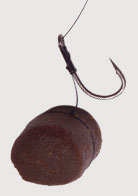 Whenever barbel are talked about, textbooks from just five or six years ago put meat, corn and maggots up there as the top barbel baits and certainly they’ll still catch their fill of barbel.
Whenever barbel are talked about, textbooks from just five or six years ago put meat, corn and maggots up there as the top barbel baits and certainly they’ll still catch their fill of barbel.
But the pellet revolution is a 21st century trend that keeps growing. Amino acids, the building blocks of proteins, are packed into pellets and are adored by barbel.
“I’ve always loved fishing for barbel,” said the Kidderminster and District AA Bailiff.
“My first barbel was a tiddler from Shrewsbury weir that I caught with maggots 40 years ago.
“You can still use maggots, but for attracting lots of barbel you just can’t beat halibut pellets.”
FAITH IN THE PELLET
Set up on Kidderminster DAA’s piece of the Severn, just above Bewdley in Worcestershire, it was instantly clear that Jason had set out on a pellet-only attack, such was his faith in the bait.
“Barbel use all their senses to search out food,” he explained.
“Like many anglers I used to be a luncheon meat man. When I saw a good match angler, called Matt Hamilton, win a match on the River Wye with 50lb of barbel three years ago on pellets I was bowled over.
“My technique of presenting pellets on the feeder is simple, and absolutely anyone can follow it for success.
“I’ve used it countless times in the last couple of seasons and I tell you, it’s won me plenty of matches too,” he said in his friendly Black Country accent.
After just 20 minutes, Jason’s rod shivered, then hooped round in as a barbel took his hair-rigged pellet, foolishly thinking that the hookbait was another free meal pushed out of the feeder by the current.
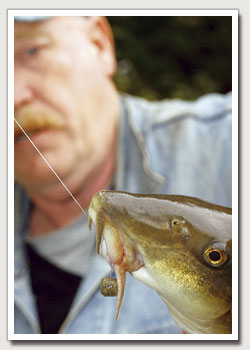 Bending his 11ft 1.75 test curve Normark Avon rod into the fish, the barbel surged off in search of a refuge in which to lose the hook.
Bending his 11ft 1.75 test curve Normark Avon rod into the fish, the barbel surged off in search of a refuge in which to lose the hook.
This peg, Jason assured me, was a snag free swim, except for a nearside bush leaning out into the water, and reaching out into the river Jason managed to turn the away from the branches.
His tackle was perfectly suited for the job, it was strong enough without being over-gunned, and after an enjoyable battle on a responsive rod, a pellet-scoffing 4lb fish was guided into the welcoming folds of his net.
SEVERN HEAVEN
With his first fish of the day safely landed Jason didn’t waste anytime recasting his pellet-loaded feeder.
As he explained, when you are relying on the potent smell of a bait to attract fish to your swim, it is essential that you use a rhythmic casting technique to inject pellets into the water.
Every 10 minutes he retrieved the empty feeder, filled it up again, and recast it into mid-river.
As he waited for the next pellet muncher to invade his swim, Jason explained the attraction of barbel on the Severn: “This is a barbel angler’s paradise,” he enthused.
“A hooked barbel is like an Exocet missile on string - the excitement and sport they provide is unique in angling.
“That’s why I’ve been living on the banks of the Severn for the last 30 years!
“It’s a river that’s well worth visiting, wherever you live, simply because of the numbers of barbel.
“There’s so much variety in the pegs. There are deeps, shallows, narrow runs and wide stretches like this peg, nicknamed the Nursery, as you find lots of juvenile barbel among the three and four pounders.
“Plus there’s always the beauty of nature to take in too!”
Proof of this final point was promptly echoed as we watched the iridescent flash of a kingfisher dart across the river.
For the price of a £3 day ticket this rivals any commercial pool for enjoyment!
TACKLE AND KIT
Feeder fishing for barbel is an uncomplicated affair. A medium to heavy feeder rod, that’s also suited for commercial carp work, fits the bill if you match it with a large fixed spool reel loaded with 8lb line.
His rig is a simple running set up, using a Dinsmores block-end feeder.
These feeders are brilliant at depositing various-sized pellets into the swim as they are robust and withstand repeated casting.
Jason enlarges the feeder’s holes by carefully twisting sharp scissor blades in them, this allows the pellets to have a quicker exit.
Using a clip on swivel (see diagram below), the feeder is left free running above a small fixed swivel carrying a 15 inch long hooklength of 8lb Terry Eustace Pro Gold line capped with a Mustad Eyed Specialist size 14 hook.
It was strong gear that was perfectly matched to the power of the rod.
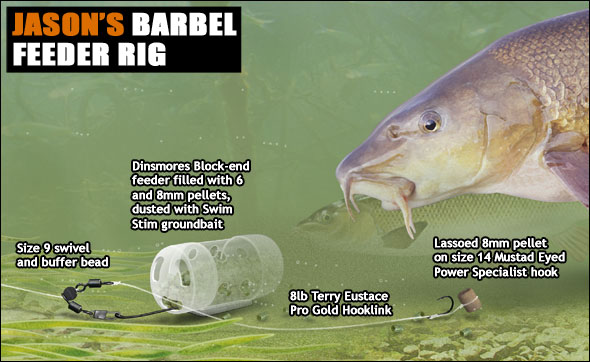
BAITING UP
If you’ve fished with pellets before you’ll know that drilling them, especially the small 8mm ones Jason uses, can be a thankless task.
All too often impatience means that they break up before you’ve finished drilling them.
However, instead of this fiddly task, Jason has come up with an ingenious loop system that lassos the bait firmly and securely in place.
Jason starts by tying a grinner knot at one end of the hooklink.
Then, before the loop is closed, the pellet is popped into the ‘noose’ which is tightened down to grip the bait.
Next, using a knotless knot, the lassoed pellet is attached to the hook. Another grinner knot is used to tie on the other end of the hooklength onto the swivel.
When it comes to rebaiting, it’s a case of using a pair of scissors or the nose of a pair of pliers to tease open the loop containing the pellet. Push in a fresh pellet, pull the loop tight and you’re ready for action again!
On a low, slow flowing river in summer, pellets can be introduced by hand, but in the autumn and winter, when the extra pace of the river would carry pellets in all manner of directions, the feeder is the most accurate way of introducing feed.
“If you fill your feeder with just pellets, one problem you can get is that they explode out of the feeder too quickly,” revealed Jason.
“The solution is to dust the pellets in Dynamite Baits Swim Stim groundbait.
“This binds the pellets together just long enough to ensure they remain in the feeder until it hits the bottom, when they’re released, right next to your identical, pellet hookbait.”
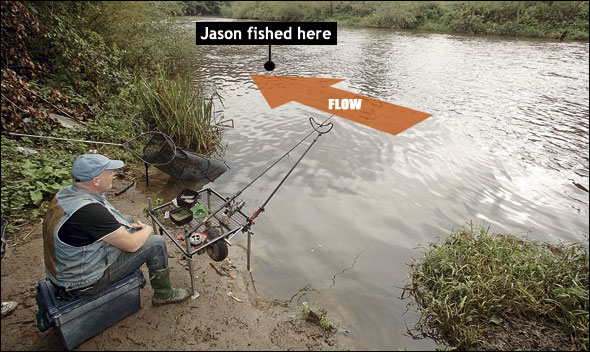
GLUG AWAY
“Barbel have great senses, both in terms of sight and smell,” said Jason.
“As a smoker I’m wary of tobacco on my fingers tainting my hookbait, I disguise this by glugging my hookbait in a bottle of Dynamite Baits Halibut liquid flavouring. It also provides an extra flavour trail.”
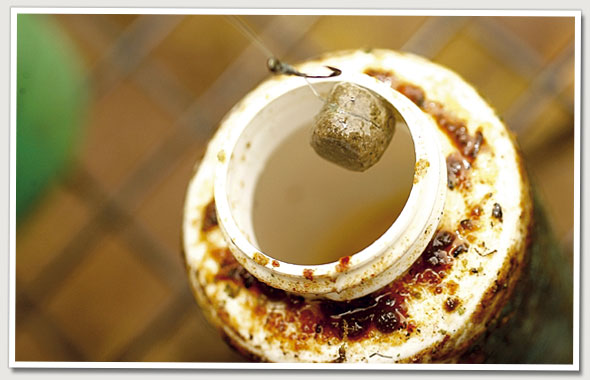
BARBEL LOCATION
Having spent over 40 years fishing the Severn, Jason knows the sort of features that make a good peg.
There are key characteristics he looks for if he’s pleasure fishing: “The first thing I look for is pacey water - flowing at least at walking speed - where there’s plenty oxygen passing through their gills.
“I look for a glide, running over small rocks or gravel.
“In summer, when you have lower flow, I’ll be looking areas of faster flow, that you’ll find on the outside of bends and where the river narrows.
“In the next few winter months I’ll be looking for easy glides offering a constant push of water.
“Boiling water, where the river is eddying around, should be avoided, barbel don’t like to have to keep constantly adjusting to a variable current.”
THE SESSION
Quickly following up with another 4lb barbel, Jason explained his options for the remainder of the session.
“I could cast slightly upstream or downstream of my baited area. It’s a big river and sometimes you have to move your bait to find the fish again,” he said.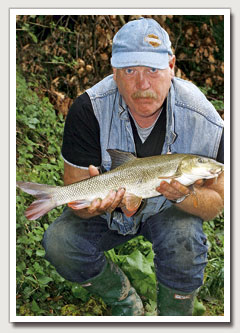
“The next possibility is to drop down in hooklength diameter and hook size. This is an option that definitely gets you more fish, when they’re not feeding properly and things are quiet.”
Following a half-an-hour lull in action, Jason duly switched from his 8lb hooklink to a 5.5lb bottom and dropped down a hook size to a number 16 Mustad Eyed Specialist.
“The reduction in hook size and line diameter may seem insignificant in a coloured river, but this has brought so many extra fish in the past that it’s always worth a try,” Jason revealed.
“Barbel are sophisticated feeders and will spit out a hookbait they are suspicious about extremely quickly.”
With his fined-down tackle Jason cast again over his baited area.
Almost immediately the quivertip rattled: “That’s a chub mouthing the bait. Just like if you’re were bream fishing, you only strike at full blooded lunges,” he advised.
We sat expectantly watching as the rod trembled once more, before lurching over again in a violent hoop.
This time, with the slightly lighter hooklength, Jason played the fish with a tad more care but he soon slid the net under the fish, soon followed by a bonus 3lb chub.
GIVE IT A GO!
“Fishing commercial waters is great, but if you want to broaden your experience then the excitement of barbel fishing just has to be tried,” said Jason.
“If you haven’t given it a go, get down to your nearest barbell river, arm yourself pellets and you’ll be hooked just like I am,” he urged.
“When you get that first flash of barbel pulsing and battling on the end of your line you’ll be going back for more and more, I promise you that!”

Tying hempseed onto a hook
Hooking hemp seed can be a real problem for some anglers, with the bait not gripping the hook securely and therefore falling off the instance it touches the water.
Most anglers hook these hard seeds by gently squeezing the ends of the shell to open up the seed a little, then inserting the hook shank and allowing the seed to clasp hold of the hook.
In the vast majority of circumstances this technique works well, but some anglers prefer to use the method detailed below, as it allows more than one fish to be caught on the same grain of hemp.
Follow the eight simple steps below and you'll soon be able to tie a grain of hemp to your hook in a matter of minutes, and catch lots of prime roach on it too...
1. To be able to tie hemp to your hook, you'll need a good, sharp, medium-sized sewing needle and some 3lb breaking strain monofilament line
2. Place the hemp on a flat, hard surface like a bait table (not your knee!) and push the needlepoint through the blunt end of the seed
3. Pick up the seed and push the needle all the way through. Wiggle the needle to make a bigger hole in the hemp seed
4. Thread your monofilament through the eye of the needle
5. Push the needle all the way through, taking with it the monofilament line
6. Tie a simple overhand knot in the line and pull the knot tight against the seed
7. Repeat process 6 so that you have got a solid knot. Then neatly cut off the tag ends. Make up a dozen of these before you go fishing
8. Slip your hookpoint under the tight loop of line you've created in the seed. You may catch a dozen fish without the bait coming off!
How to hook maggots the right way
Maggots remain one of the best all-round fishing baits in angling because there isn’t a freshwater fish that won’t happily eat masses of maggots.
Different anglers have different colour preferences with reds and whites being by far the most common. Some anglers swear by flavouring their maggots, others like to use them ‘neat.’
But one thing’s for sure. A poorly hooked maggot won’t catch half as many fish as a properly hooked grub, and some species like skimmer bream will actively avoid ‘burst’ hooker maggots that ooze gunge (see sequence below.)
1. Use as sharp and fine wire a hook as you can get away with and aim to barely nick the maggot in the point of the skin on the flat end
2. By simply nicking the skin like this the maggot will continue to wriggle for long periods, attracting hungry fish
3. This is how NOT to hook a maggot. The maggot has been impaled down the body with a blunt hook and ‘burst’
4. For a double maggot bait repeat No 1. If fishing close in/on the pole, you want the pointed end of both maggots pointing down
5. If fishing a float or bomb at long range, hook your maggots like this. This stops them spinning on the retrieve, causing line twist
6. Shy biters like roach and crucians may nip the end of a normal single maggot (Pic 2), so thread the hook like this to trick them
7. Here’s another way to stop maggots spinning on a retrieve. Hook one as in Pic 6, then nick another through the sharp end
8. Another way to foil delicately biting fish that repeatedly nip the end of the maggot is to hook it through the sharp end instead!
How to use paste
With its soft texture, instant attraction and awesome fish-pulling power, paste is one of THE best summer carp baits.
G.O.T Baits’ Gary Thorpe shows you how to get the best from it…
Having predicted a catch of well over 100lb by three o’clock, it looked like Gary Thorpe would achieve this goal in half that time.
With his swim almost solid with feeding carp catching them was easy, with hardly a minute going by before his elastic was at its fullfighting stretch.
But what had worked the fish into such a feeding frenzy?
The answer was a simple one – it was Gary’s paste bait.
Neglected by many, and wrongly dismissed by others as being too fiddly to prepare or impossible to keep on the hook, paste is a fabulous bait in the right hands.
In fact, Gary believes the anglers who aren’t willing to give paste a chance are making a mistake that’ll cost them a lot of fish.
And who would argue with one of the greatest paste anglers in the country and the current World five hour match record holder with a haul of 490lb 8oz of carp?
HOW TO MAKE GARY'S PASTE
Gary makes his hookbait up from G.O.T Baits ‘The Ton Up Paste’ powder.
“I prefer to make my paste from a powder because I can make it as stiff or as soft as I want with the addition of more water, or by adding less in the first place,” explained Gary.
“The trouble with readymade pastes is that you are stuck with what you are given, the majority of which are too stiff in my opinion.
“Don’t get me wrong, ready-made paste has its place, it’s great at close range on the waggler, but for pole fishing I like powdered paste that I mix soft.”
STEP ONE
Empty the contents of the bag into a suitable mixing bowl or bait tub.
STEP TWO
Start adding water to the mix a little at a time and mix the two together with your fingertips.
STEP THREE
The mix should become wetter. Leave it to stand for 15 minutes to enable the powder to fully absorb the water.
STEP FOUR
The paste is now ready for fishing with. Ideally it should be quite soft but just firm enough to grip the hook.
SETTING UP AND KICK STARTING THE SWIM
We joined Gary at peg 32 on the prolific Alders’ Farm Fishery Match Lake, where he was setting up a pole and the rest of his tackle for the day ahead.
It was a balmy, overcast summer day, with a light southwesterly wind causing an inviting ripple to form across the water.
All over the lake there were carp leaping clear of the water, just like returning salmon on a great Scottish river.
“Looks like we should have a few,” said Gary.
Hooking a rig on to a top-three kit of his pole, Gary added just three more sections to take the pole to six metres.
“I like to fish close in when I’m fishing with paste because it makes things so much easier,” said Gary. “The further out you fish, the further you have to bring the pole back, should you miss a bite or your paste falls off.”
At this distance, Gary plumbs the depth straight ahead of him and explores elsewhere in the swim to the left and the right.
“Plumbing up is very important in fishing, but it’s even more important when fishing paste,” said Gary. “The first thing I look for is a level and uniform bottom. It is no good trying to fish paste on a sloping bottom, as the paste will come off the hook and roll away, out of the swim.
“It’s vital to set the rig at dead-depth (the exact depth of the swim) as you will hit more bites and the paste won’t sink the bristle of the float at this depth.
“Fishing at dead-depth also helps to reduce the amount of foul hooked fish, where a fish swims into the line and causes a ‘false bite’ to register on the float.
“This can be one of the major problems when fishing with paste, as it really turns the fish on to the feed. The disadvantage of that is they go wild and will often swim into the line and cause a false indication.
“Unfortunately, you can’t really stop this happening, but the more you fish with paste the better you’ll get at distinguishing the false bites from the proper ones,” said Gary.
THE ADVANTAGES OF PASTE
As he started to tackle his swim Gary explained the reasons why paste baits are so good at this time of year.
Most obviously paste has instant appeal because it has no outer skin. Unlike a boilie or a pellet, a paste bait ‘activates’ the instant it hits the water, pumping out a slick of flavours and oils to attract the fish.
A well mixed, soft paste also has a texture fish like to eat, and if you use a big chunk it will also be an obvious target for a passing fish.
In fact Gary reckons it’s a bait that gives rapid results: “Bites are instant on paste - that’s what I like about it!” he said. “If fish are in the peg, look for a bite within minutes, if not seconds of lowering the bait in.
“If I’ve not had a bite after two or three minutes, I strike the paste off the hook, bring the rig in and re-bait with a fresh chunk. The beauty of this it that you are constantly topping up the swim as the session goes on.”
THE DISADVANTAGES OF PASTE
Despite its fish-catching ability paste does have a couple of drawbacks that do discourage some anglers from trying the bait.
The first problem many anglers meet is that the bait needs to be very soft to be at its best. This makes it difficult to use on rod and line as it tends to be flung off the hook when casting. It is a better bait for use on the pole.
Alternatively, you can use a stiff paste, moulding it around a bead, or paste cage, but in Gary’s opinion the hooking rates aren’t nearly as good with a firm paste. He prefers a soft bait, as it allows him to strike through it and straight into the fish’s mouth with nothing to impede it.
Another disadvantage is how time consuming it can be to produce the perfect paste. Many anglers who’ve experimented with making paste for themselves have found it very difficult. Lots of anglers have ended up with ruined bait that’s too hard or too soft!
Thankfully bait firms have now made many of the commercially available powdered paste products much more user friendly.
Some products have mixing instructions marked on the packet, while some paste powders even have a ‘water level’ printed on the packaging to direct you to mix the bait perfectly every time.
We’ve rated some of the ready-made pastes, see page 45 for our results. But these slight negatives don’t hide the fact that paste can catch more carp than any bait if you can perfect its use.
THE RIG TO USE WITH PASTE
Keep it simple is Gary’s advice when it comes to fishing with paste.
The first step is to select a float with a long, thick bristle that shows little dips of the float indicating a false bite and a longer stem to help make the float more stable in the water.
Always pick a float with a fibreglass or carbon stem rather than a wire one, these materials don’t bend like wire does.
The line Gary prefers is 7lb 8oz breaking strain (0.18mm) tied straight to the hook.
“I’m fishing for a large weight of big fish so the rig takes a lot of stick. Adding a hooklink would create a weak point,” he explained.
Gary’s shotting pattern was also simple with a bulk of number 8 shot halfway down the rig.
“There’s no need for sensitive dropper shots with this type of fishing as you are just looking for fast, positive bites,” said Gary.
“The bulk gets the bait on the deck quickly, where the fish are feeding.”
The rig was then completed with a strong size 14 Kamasan B911 hook.
“Always use a heavy-gauge carp hook when paste fishing,” Gary continued. “You’re doing a lot of ‘carp crunching’, so the hook needs to be able to cope with it,” he added.
THE SESSION
After plumbing up and cupping in a handful of 4mm pellets and a few chunks of G.O.T Baits Ton Up paste, Gary moulded a large chunk of paste around his hook, put it in a small pot attached to his pole, and shipped out.
Holding the pot just above the water, he then rotated the pole to drop the soft hookbait into the lake. After the float settled, it was just seconds before he had his first bite from a feisty 3lb Alders Farm carp.
Rebaiting, Gary shipped his rig back out into the water, eager to capitalise on this early success.
After fishing for 15 minutes, Gary had landed six carp, before the line went quiet – if you can call no bites for five minutes quiet!
To restart his peg Gary started flicking out a few pellets at minute intervals. He also began striking the paste off his hook if he hadn’t had a bite within two minutes.
“By striking the paste off the hook I’m constantly topping up the swim with free offerings,” said Gary.
Within 10 minutes of introducing the feed the carp reappeared and the pattern for the day was established.
Almost every put in saw Gary hook a fish of between 3lb and 8lb - the bait was usually taken within seconds of it hitting the lake bed.
After just four hours of angling and with his TWO giant keepnets already filled with fish, Gary had amassed a total haul approaching 200lb.
It was an incredible performance and gave clear evidence of how good paste is as a summer bait.
What’s more, with some of the modern commercial paste mixes reaching new heights of quality there has never been a better time to mould a piece round your hook.
If you’ve never tried it make the summer of 2006 your year of paste exploration - you won’t regret it!
Gary's top 5 paste tips
1. Take time getting the consistency of your paste right. It should be smooth, with no lumps and should just leave a slight residue on your fingers when you are handling it.
2. Keep it simple. There is no need for complicated rigs or shotting patterns when fishing with paste, let the bait do its job.
3. Try to fish as close in as possible. This makes soft paste a lot easier to fish.
4. Plumb the depth accurately using a plummet. The paste must sit perfectly on the bottom.
5. Feed regularly through the day. On commercial fisheries the fish are hungry, especially at this time of year, so you’ve got to keep some freebies going in on a little and often basis.
The complete guide to boosting your baits with flavourings
Natural extracts, artificial flavours, powders, dips, glugs and soaks exist to help you catch more fish. Here’s how, when and why you should use them...
There was a time when flavouring your bait involved nothing more technical than smearing a bit of honey on a piece of bread flake.
These days, bait additives are produced on a grand scale by a multi-million pound industry.
We’ve split these attractors into four families and have even provided a few recipes for you to try...
Natural Extracts
Drawn from real edible products, these liquids are loaded with natural proteins, including amino acids.
Aminos are the organic substances that animals recognise as being a signal leading to food.
Put simply, if they locate the source of amino acids they know that item is edible.
Although natural extracts are not as concentrated as many artificial flavours and can be used at higher dosages, they still deliver a potent attraction.
They can be added to pellets, mixed with water for use with groundbait or used as a soak for hookbaits to be left sitting in.
Although these liquids were first developed for use in boilies by specimen carp anglers, they are great products for tempting almost any fish that swims. Some of the best are pictured.
SUGGESTED RECIPES: Add 20ml-50ml of Nash Pure Liver Extract, Nutrabaits Nutramino, Corn Steep Liquor, Bag ’Em Matchbaits Molasses to the mixing water added to every kilo of dry groundbait. Extracts can also be used undiluted as a soak for hookbaits like corn, boilies, meat and pellets.
Artificial flavours
These are chemical liquids that have been developed to mimic the smell and taste of different foodstuffs.
There are literally hundreds on the market and they can be used to customise baits, giving your offering a unique appeal.
Hutchinson’s and Nash’s Chocolate Malt is a classic, as are Nash’s Scopex and Strawberry. Pineapple flavours, like Mainline’s and Solar’s varieties, are also among the favourites.
But here’s a word of warning; these flavourings are very strong – often boasting a 1,000-1 concentration level – so you need to use them very sparingly. Half to one teaspoonful of flavour (2.5-5ml) is more than enough to boost a pint of pellets or a kilo of groundbait.
Do not make the mistake of piling more artificial flavour into your bait on the basis that more flavour equals more bites – it doesn’t.
Coarse fish have a sense of smell and taste that is hundreds of times better than ours and they can detect microscopic amounts of a chemical dissolved in water. Fish may even be repulsed by a bait that smells too powerful.
If you are using strong artificial flavours your bait should carry a mere whiff of scent rather than a stench.
A good edge over anglers who are only flavouring their baits is to add a touch of flavour enhancer or sweetener to your bait, too. This ensures that your bait doesn’t just have a distinctive smell but also has a pleasant taste.
Lots of firms make products that do this job with Solar’s Liquid Candy Sweetener and Nutrabaits’ Sweet Cajouser being among the most highly reputed.
SUGGESTED RECIPES: Blend 2ml of sweetener with 2.5ml- 5ml of flavour (per kilo of pellets/groundbait or pint of maggots/corn).
Powdered flavours
Some bait firms have produced powdered bait additives which make up part of the mix itself and release attractors slowly, over a long period of time.
Van den Eynde’s Brasem powder is a classic. Sweet and intensely creamy, it is a marvellous ingredient that bream, carp and tench seem particularly attracted to. VDE’s Bloedmeal power is loaded with savoury/meaty attractors that can really give your groundbait a special appeal. Tench and carp love the stuff.
Ground turmeric is also a great additive if you want to try a spicy mix for carp and, if roach are your number one target, track down some powered coriander.
Why they like it so much nobody knows – but it works.
SUGGESTED RECIPES: Usually, add 2-4 desert spoonfuls of powder to a kilo of dry groundbait. Some powders are very strong, so be careful not to overload the bait.
Bait soaks, dips and glugs
This family of flavours is probably one of the most misunderstood yet they are also very useful for anglers who just wish to boost their baits without spending a fortune on blending different potions.
Variously labelled bait soaks, dips or glugs (you ‘glug’ your bait in these syrupy liquids), they were first designed by carp bait firms to boost boilies.
But they have transferred across to the coarse fishing market where they’re used by some of Britain’s best match anglers. So, what are they?
These are blends of several different attractors that are fused into one potent liquid that smells good, gives a bait an improved taste and boosts it’s food signal. In differing quantities they usually contain flavour, taste enhancer/ sweetener and natural extracts.
While this means they are concentrated and do have a strong smell/taste, they can be used more liberally than a neat artificial flavouring.
Dynamite Baits produce a huge range of these attractors. Some, like the Pineapple Attractant, are heavily flavoured but others, like Source and Spicy Chicken Attractant, contain lots of natural extracts and can boost any bait.
Nash also produces a fabulous range of bait soaks under its Food Dip banner, with the Squid Scopex and Shellfish Sense Appeal having natural extracts with a dash of flavouring.
Mainline’s Hookbait Enhancement System range also marries flavours with powerful natural fish attractors and both Mistral Baits’ Booster Dips and Bag ’em Matchbaits Natural Attractor liquid will boost your hookbait. Nutrabaits’ Bait Soak Complex range is top quality.
SUGGESTED RECIPES: Typically, 10ml-20ml (two to four teaspoons) of glug can be added to the mixing water for a kilo of groundbait or pellets. These liquids can also be used as an overnight marinade for your soft pellets, boilies, corn or meat.
How to get the best from bait flavourings
The number of flavours and bait enhancers available to the angler is huge. From liquids to sprays and powders, there is an additive for all occasions.
There is no argument that these additives give you an edge but how do they work and how do you use them effectively?
Flavours work on two levels - instant attraction and long-term appeal.
IMMEDIATE ATTRACTION
Flavour on the outer edges of the bait disperses as the dosed bait hits the water, it is the initial ‘hit’ that draws fish towards your hookbait. Water-based flavours hang low to the bottom, tempting fish like carp, barbel and bream. Oil-based flavours will rise through the water and attract mid-water fish such as roach.
LONG-TERM ATTRACTION
A large portion of the flavour must remain inside the bait, leaking slowly so that it attracts over a longer period of time. It is also important to use flavours or enhancers that boost the taste of a bait. Fish that like eating a particular offering will keep coming back for more, this means your catch rate rises.
Here's a few ways to use flavours to help enhance your feed and hook baits...
Flavouring groundbait...
Powdered additives are best mixed with the dry
feed prior to wetting.
Low concentrate flavours can be added to the
wet or dry mix...
...or better still, they can be blended with the
mixing water for an even spread.
The flavoured water can then be used to
dampen the groundbait.
Flavouring boilies...
Drizzle a bait soak liquid or a natural extract
on the boilies...
... above left is the unsoaked bait and on the
right is the soaked one.
Several firms produce pump flavour sprays for
extra instant attraction
Hookbaits can also be 'glugged' in syrupy flavour
dips before casting.
Flavouring luncheon meat...
Cut a tin of meat into cubes, put it in a plastic bag and pour low-concentrate flavour on top.
Trap some air in the bag and shake it to ensure all the meat gets a coating of liquid flavour.
Fridge the flavoured meat overnight to allow the attractor to penetrate the bait.
Flavouring hard pellets...
Get a low-concentrate flavour or bait soak and squirt a teaspoon or two of liquid onto the pellets. Shake the baits to give each one a coating of liquid then leave them to stand for 15 minutes. Soem of the flavour penetrates to boost long term attraction.
Unsoaked pellets (far left) with flavour-doused pellets next to them. In the water some flavour is instantly released, more leaks as the pellet collapses. Don't pour neat concentrated boilie flavours on pellets - they could be over-powering to the fish.
Flavouring sweetcorn...
Sweetcorn is a great bait when it remains unflavoured. But if corn has been used a lot on your fishery give your bait an 'edge' by adding a natural extract. Van den Eynde's Liquid Molasses is a good quality and a cheap additive
Several pumps with a flavour spray, like this Richworth one, boosts the instant appeal of your corn when it hits the water. Don't add too much flavour to the kernels as it may put the fish off!
Flavouring maggots...
Sieve away the maize on the maggots and squirt them with low concentrate flavour.
Rub maize meal inside the container (it stops the maggots escaping) and leave for 15 minutes.
Dust the maggots with fine maize meal - it sticks to the excess flavour and soaks it up.
Rub the maize through the baits to coat them. In water the maize leaks flavour to attract the fish.
These maggots were boosted with Van den Eynde Sweet Scopex liquid and are now perfect for bream, carp, roach and tench.
Feeder fishing with bread for carp
“Bread… who the hell still uses that?” is the reaction you will get from most anglers these days. But bread is STILL is one of the best angling baits that you can use.
These days it’s sadly relegated to the back of the bait tray, branded by many anglers as old fashioned and just plain boring.
Nothing could be further from the truth.
Bread will catch virtually every species of fish that swims, whether they have been heavily fished for or not.
From the smallest roach to the biggest carp, they all have a fatal attraction to it.
In order to put bread firmly back on the angling bait map, we met up with Maver sponsored angler, Andy Kinder.
Not just a superb individual angler, Andy is also a regular team member with the prolific match-fishing team, Barnsley Blacks. An accolade not to be taken lightly!
We joined Andy for a pleasure session where he planned to show us a few tips and tricks when feeder fishing bread for commercial carp…
Every five minutes saw another bread-filled feeder clattering into the water with pinpoint accuracy, two rod lengths away from an island in Andy’s swim. The spot was preordained because as Andy was setting up, a large carp crashed out of the water in the very area his feeder now kept hitting.
It would only be a matter of time. After sinking the line and winding the reel very slowly to put a slight bend in his quivertip, Andy sat back and waited.
The first signs of fish were a couple of trembles on the rod, moments later it sprung round and Andy struck.
The water temperature was still very low so the carp put up much less resistance than it would in summer.
The fight was one-way, ending in the soft mesh of Andy’s landing net a couple of
minutes later. The result was a fine-looking mirror carp of around 3lb. Hopefully, it was the first of many.
WHY USE BREAD FOR TARGETING CARP?
Bread is one of the all time classic baits that will catch nearly every species that swims, although carp have a real love of the stuff. But why is it so good?
There are a number of reasons. Firstly, being bright white, it is an extremely visible bait and something that the carp will home in on very quickly.
Secondly, it is very cheap and readily available in every shop in the land.
Another advantage of the common loaf is its versatility. There are many things you can do with bread.
You can use a punched pellet or large chunk of flake on the hook. It can be liquidised or mashed into a lovely groundbait. Bread can even be coloured, flavoured or fished in conjunction with other baits such as maggot, caster, worm or corn.
These latter bait mixtures are know as cocktail baits and are much loved by carp, tench and bream.
A fourth benefit is it becomes waterlogged and fluffs up, helping to mask the hook as soon as it enters the water.
Andy told us: “My favourite type of bread is the cheap, white long-life variety. Longlife loaves are much stickier and tackier than other breads.
This allows it to hold on to the hook better, particularly when fishing bread flake.”
PREPARING YOUR BREAD
In the warmer months, when you’re looking to catch a big weight on the feeder, you need to prepare a fair amount of liquidised bread to fill your swimfeeder with. Andy thinks nothing of liquidising three or more full loaves for a days fishing. The other little tip that he uses to great effect when targeting carp is to leave the crusts on each slice.
This keeps the bait quite active as some of the particles will sink and some will rise creating a column of bread particles. Not only will this help to pull fish down from the upper layers of the water but it also creates a kind of mini snow dome on the lake bed, with loads of bread fragments colouring the water around your hookbait. When the carp comes into the swim looking for food, the only substantial morsel it will find is your hookbait.
“The other advantage of leaving the crusts in your liquidised crumb is it allows you to experiment with hookbait presentation,” said Andy. “Because there is a column of bread particles rising and falling in the swim, you can try fishing hard on the bottom or pop your bait up in order to see which gains you more bites through the day.
“The most important thing when fishing with bread is to keep the feed going in so that you create an active feed area. By casting every five minutes you generate a cloud of feed for the fish to investigate, with only your hookbait in the middle.”
When it comes to liquidising his bread for the feeder, Andy is a bit of a traditionalist as he only uses plain bread (above).
By blitzing a few slices of bread at a time in a food processor you create a fantastic groundbait made up of millions of tiny bread particles.
The best bread to use is a cheap, white processed loaf. The inherent moisture in this product helps to hold the particles together when squeezed into a ball or a feeder. However, once the ball or the feeder hits the water, the bread will immediately break up, shattering into thousands of tiny bits of bread, laying down a lovely carpet of edible morsels for the fish to pick over.
Alternatively, a pre-prepared, shopbought, coarse white crumb (see page 111) is also available called Punch Crumb.
To boost his Punch Crumb Andy adds a little flavouring, his favourite additive being Van Den Eynde Liquid Super Scopex.
“This is a product that’s been designed as a groundbait additive and not a pure flavour so it’s difficult to add too much,” Andy explained. “To use it with my Punch Crumb, I add the flavour to the mixing water. This enables the finished groundbait to have a more consistent flavouring level than if I added it later.”
The other little tip that Andy employs is to add a little Van Den Eynde Dynamic Feeder groundbait at a ratio of four to one.
“Dynamic Feeder is more of a silverfish additive really,” said Andy. “But when the carp are cruising midwater, the activity of the groundbait can really help to pull the carp into the swim, it’s ideal when I’m fishing with a popped-up bait.”
1 Start by
placing three
or four pieces of
sliced bread into a
liquidiser.
2 Give the
bread slices
a few short blasts
with the liquidiser
to break the large
slices down.
3 Give the
liquidiser a
shake and then re
blast for about 30
to 40 seconds.
4 Don’t
obliterate the
bread, you should
be looking to turn
it into a fluffy mix
containing bits of
crust.
HOW ANDY HOOKS HIS PUNCHED BREAD
A lot of anglers avoid using bread on the hook as they think it comes off too easily. Andy gets around this problem by punching out pellets of bread, then hair-rigging them on to the rig.
Andy takes three slices of processed bread and places them on a hard surface. He then uses a Maver ‘Match This’ Bait Punch in order to press out a small barrel of bread. This is then slid on to the hair before casting in.
“The reason I use three slices, rather than just one is that it makes a good-sized pellet, good for attracting the attentions of any passing carp and once the punch takes on water it will expand, masking the hook. This provides me with a better presentation,” Andy explained.
ANDY’S FEEDER RIG
Andy’s rig for the day was set up running style.
The feeder that Andy chose for the day was a medium 20-gram cage feeder, ideal for targeting carp as it provides a reasonable payload without overfeeding the swim. If he gets a lot of bites, Andy will increase the size of his feeder, however, if the fish are hard to come by he will fish with just a leger bomb.
During today’s session, the carp were not ‘having it’. The previous snap of cold weather had really turned the carp off.
After making a few casts at the start of the day, Andy had an early fish. This lulled him into a false sense of security as it was the last bite he had for a couple of hours. By ringing the changes, putting out less bait and popping the hookbait up, Andy again managed to wheedle out another pair of carp.
At the end of a difficult day, Andy’s bread attack had managed to put fish in the net whilst others blanked!
The liquidised bread test: What should happen to your feed...
1 SECOND...
The punch crumb ball hits the water and floats.
2 SECONDS...
The ball should still float but slowly start to break up.
3 SECONDS...
The ball of punch should now start to sink, very slowly.
5 SECONDS...
The ball continues to break up as it slowly decends.
7 SECONDS...
Most of the ball has broken up, leaving a cloud of bread crumb.
How to create bread punch barrel
1 Place three slices of bread on top of each other, then place them onto a hard surface. Punch out a bread barrel with a Maver Match This Bait punch.
2 Using a fine baiting needle, remove the bread punch barrel from the bait punch and hook the needle over the loop of the rig’s hair.
3 Carefully slide the bread barrel off the needle and onto the hair of the rig. Lock the bread in place with a bait stop.
4 The finished baited rig should look like this, with the bread barrel hanging just below the hook.
Alternative bread-based hookbaits
CRUST
Crust tends to be used when targeting larger carp. As bread crust is buoyant, the best way to fish with it is either on the surface or when you are looking to fish a popped-up bait. An uncut loaf provides the best crust. In order to prepare the crust for the hook, leave an uncut loaf in a polythene bag for a couple of days. This allows it to sweat producing a tough, rubbery crust that will stay on the hook much longer.
FLAKE
This is one of the most widely used of the bread baits. You can use a sliced loaf for bread flake, but the soft doughy inner of an uncut loaf makes by far the best bread flake. In order to mount bread flake, simply tear off a piece about the size of a fifty pence piece. The bait should be pinched around the shank only, but not compressed too much. In the water you want the flake to swell up and look as natural and as fluffy as possible.
COCKTAILS
Bread is such a versatile bait that it can be combined with any other hookbait you care to mention. These combinations are called cocktail baits. The combination of the high visibility bread flake combined with the movement or colour contrast of another bait such as a maggot, caster, piece of sweetcorn or a worm is something that carp, bream and tench find simply irresistible.
FAKE
Fake baits are all very much the vogue these days and have been the downfall of many specimen fish of all species. The great thing about fake bread is it is highly resilient on the hook, it looks very good under water and more importantly, it catches fish! Being made of rubber, it is bouyant and so ideal if you are looking to fish with a popped- up bait, when you are fishing over weed.















